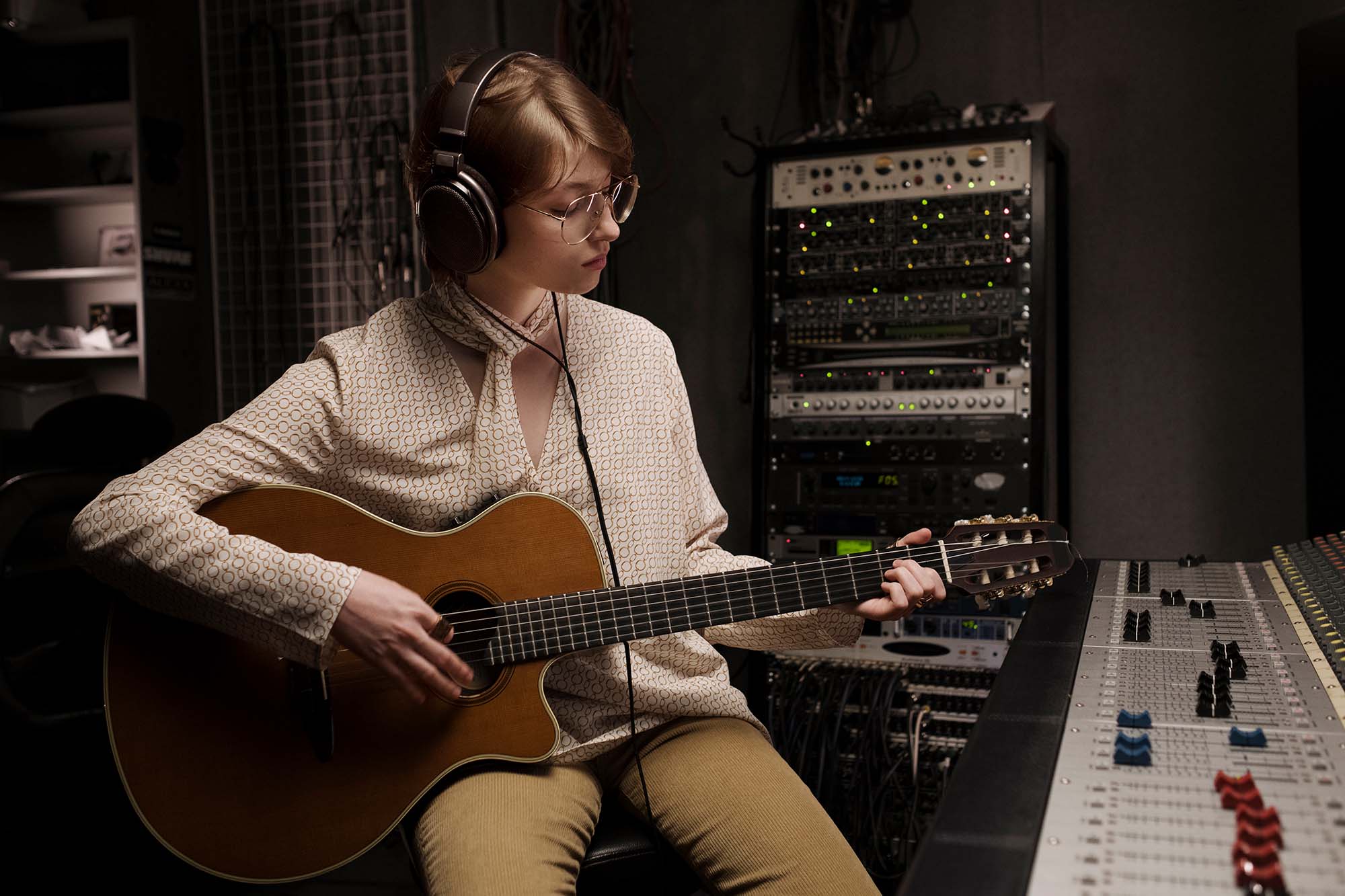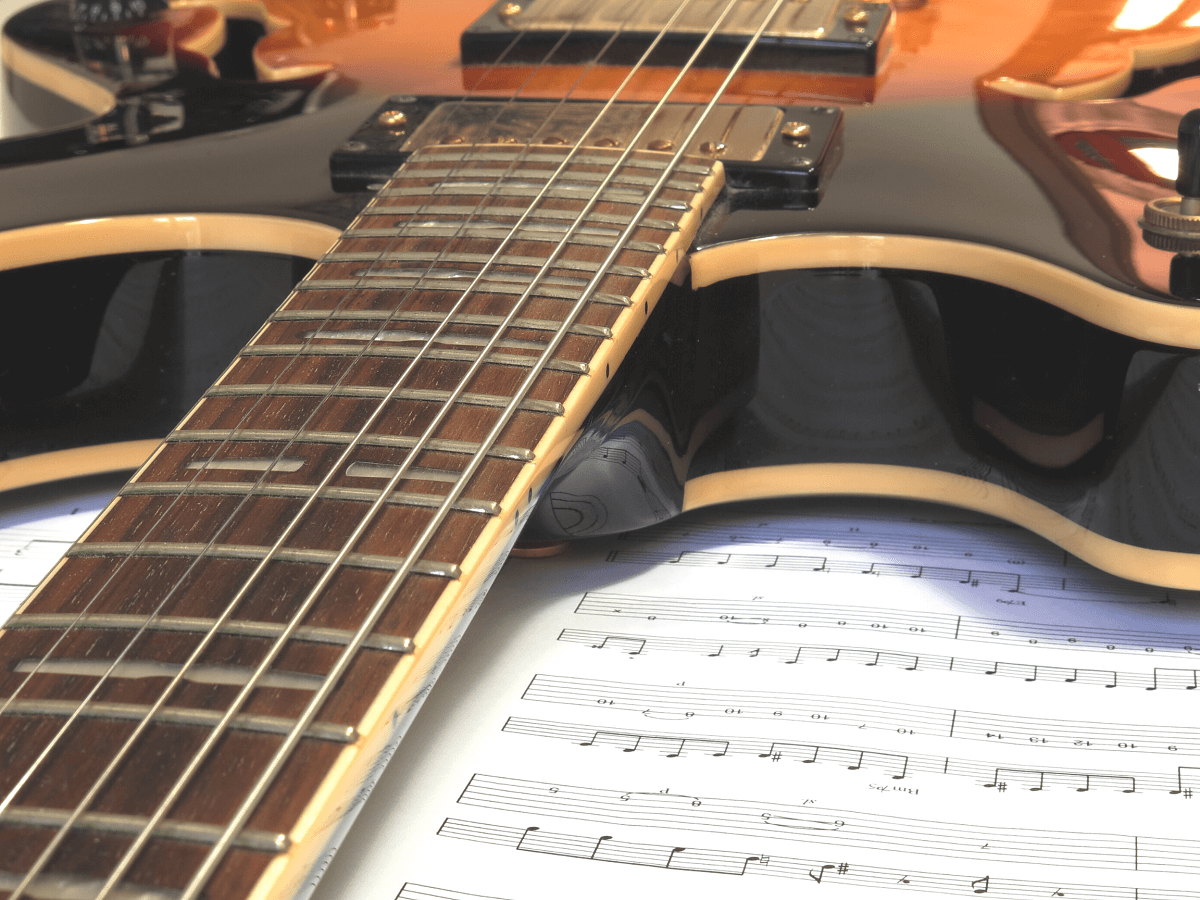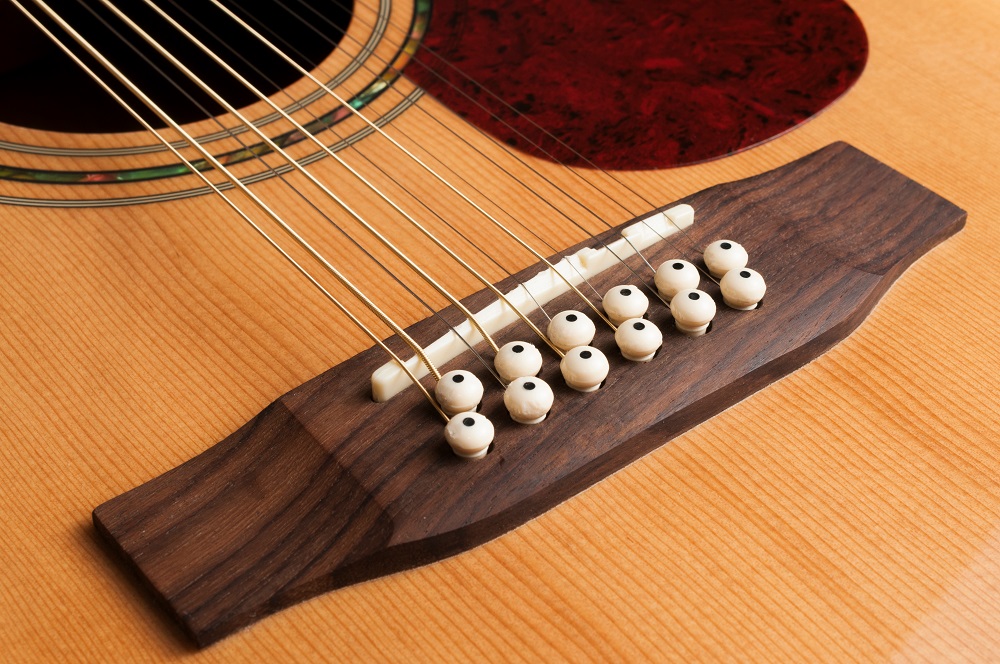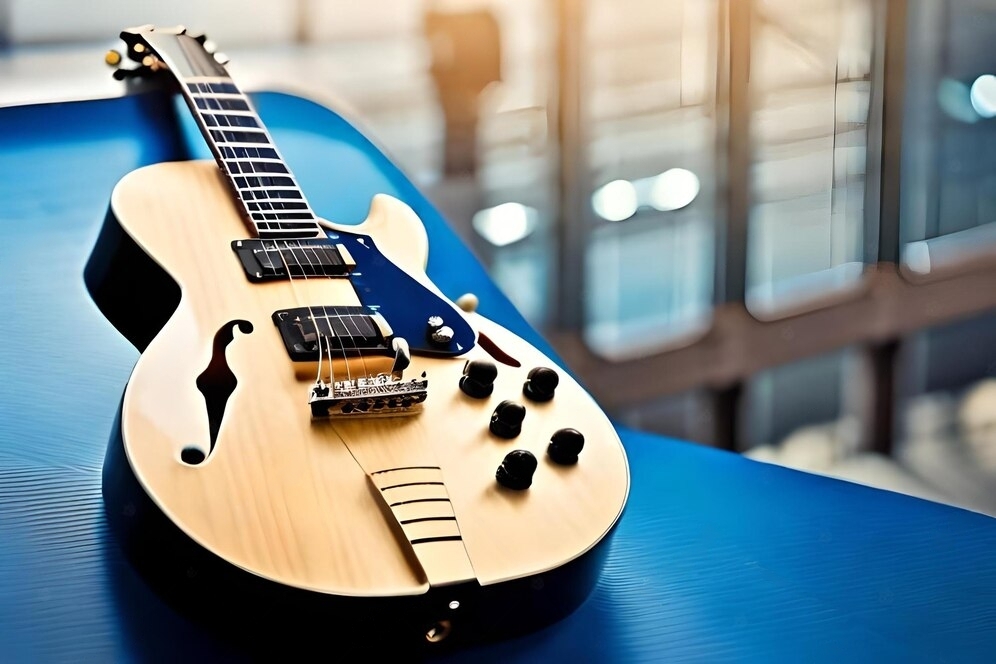Understanding the critical role acoustic guitars play in studio recording can enhance your music production profoundly.
Choosing the ideal acoustic guitar carries a significant impact on the tone, quality, and overall success of your audio output.
Amongst the plethora of options available in the market, finding the one that resonates with your requirements might be overwhelming.
Therefore, we have carefully selected and critically analyzed instruments that have proven to offer outstanding performance during studio recording.
Every detail including tonal characteristics, durability, and affordability has been taken into consideration.
This list is designed to streamline your selection process by presenting the top picks from both established and emerging brands.
Table of Contents
- Best Acoustic Guitars For Studio Recording
- YAMAHA FG800 Solid Top Acoustic Guitar
- Epiphone Dove Studio Solid Top Acoustic-Electric Guitar
- Seagull S6 Original Acoustic Guitar
- Taylor 214ce Plus Grand Auditorium Acoustic-Electric Guitar
- Takamine GD-20 NS Acooustic Guitar
- Epiphone Masterbilt Frontier Acoustic-Electric Guitar
- Taylor 100 Series 2017 114e Grand Auditorium Acoustic-Electric Guitar
- Epiphone Hummingbird Studio Acoustic-Electric Guitar
- Fender CD-140SCE Dreadnought Cutaway Acoustic Guitar
- Yamaha A5R ARE Dreadnought Cutaway Acoustic-Electric Guitar
- Washburn Festival EA15 Mini Jumbo Cutaway Acoustic-Electric Guitar
- Martin LX1E Little Martin Acoustic-Electric Guitar
- Epiphone J-45 Studio Solid Top Acoustic Guitar
- Taylor 324ce Acoustic-Electric Guitar
- Martin D-15M Acoustic Guitar
- What Features to Look for in a Studio Recording Acoustic Guitar?
- How Does Wood Type Affect the Sound of Acoustic Guitars?
- What String Types Are Recommended for Studio Recording?
- Does the Shape and Size of an Acoustic Guitar Impact Sound Quality in Recordings?
- What is the Significance of the Neck Joint in Acoustic Guitars for Studio Recording?
- How Important is the Bridge System in Studio Recording Acoustic Guitars?
- Is there a Notable Difference Between Solid or Laminated Acoustic Guitars in Recordings?
- Which Guitar Brands are Frequently Used in Recording Studios?
- Should You Have Multiple Acoustic Guitars For Different Studio Recordings?
- What Guitar Maintenance Tips Can Enhance Studio Recording Performance?
- The Bottom Line
Best Acoustic Guitars For Studio Recording
Before I begin, here are my top selected choices:
|
|
Epiphone Hummingbird Studio Acoustic-Electric Guitar

Quality build with excellent electronics and aesthetics. Check Price
|
Washburn Festival EA15 Mini Jumbo Cutaway Acoustic-Electric Guitar

Quality acoustic-electric guitar with superior craftsmanship.
Check Price
|
YAMAHA FG800 Solid Top Acoustic Guitar
Affordable, high-quality Yamaha acoustic with solid-top.
This acoustic guitar features a solid sitka spruce top, nato back and sides, and a rosewood fingerboard and bridge. It comes with diecast tuners and an adjustable truss rod, ensuring high-quality sound and durability. Particularly suitable for beginners, it possesses an authentic, balanced sound that doesn’t compromise on robust strength.
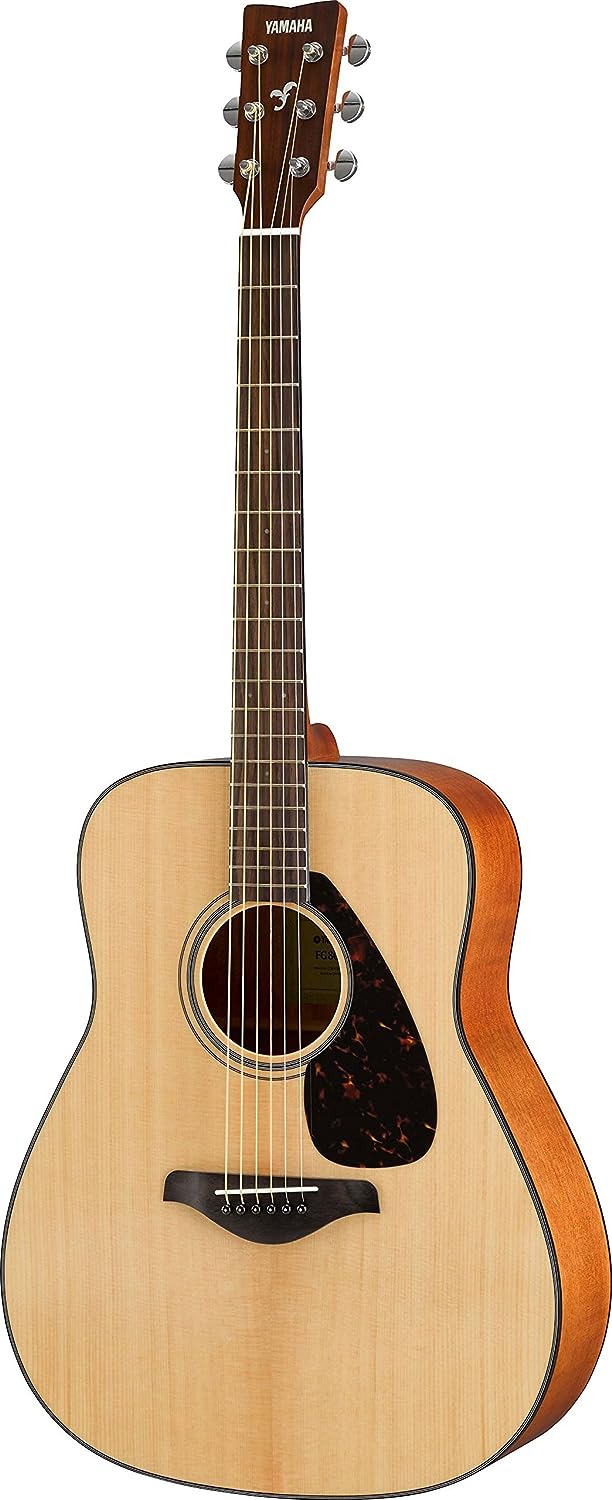
The Yamaha FG800 is an acoustic guitar, remarkable for its solid top made from Sitka spruce.
This guitar catches the eye with its natural color that beautifully showcases the quality of the materials used.
We also appreciate the beautiful combination of Nato wood on the neck and rosewood on both the fingerboard and the bridge, adding to the overall quality of the instrument.
Adding to its durability and ease of tuning are the diecast tuners.
It also features an adjustable truss rod, enhancing the guitar’s flexibility and playability.
The guitar was designed by the trusted brand, Yamaha, known for their outstanding quality in musical instruments.
The materials used for this model are mainly made of a spruce top with a mahogany body and a rosewood back.
The neck is crafted from Nato wood while it also sports a rosewood fretboard.
This guitar is designed for right-handed players and uses phosphor bronze type strings.
Yamaha’s FG800 model stands out for its traditional look combined with robust strength, offering an authentic and well-balanced sound.
It boasts a newly developed scalloped bracing design and can be recommended to beginner guitarists seeking an affordable yet high-standard guitar.
- My Review
Upon first glance, the Yamaha FG800 strikes you with its simple yet elegant design.
The natural color of the finish lends it an authentic look, which I personally found immensely appealing.
One of the most important features of any guitar, be it for a beginner or an experienced player, is the material of its top.
In this case, Yamaha opted for a spruce top, renowned for offering strikingly clear and resonant sound.
When I strummed this guitar for the first time, I instantly fell in love with the deep, melodious resonance.
It’s quite a marvel how this modestly priced instrument can fill the room with sound quality that will easily make you wonder how much you’d spent.
Remarkably, the Yamaha FG800 isn’t just about sound; there’s an obvious emphasis on quality craftsmanship.
The back and sides made from nato wood and the rosewood fingerboard in combination resulted in a guitar that was not only visually appealing, but comfortable to play as well.
However, I have to mention that one might encounter a few hiccups along the way.
Firstly, the setup of this guitar may require some extra attention.
When I took it out of the package, the action seemed a bit high, and although it’s not a major issue, some adjustment was necessary for a smoother playing experience.
Secondly, I had a bit of trouble with tuning the e string, but with some time and patience, I was able to overcome this issue.
Bearing in mind the affordable price tag, one can expect minor setbacks that are easily solvable with a bit of effort.
As for its performance, this guitar doesn’t shy away from making a strong impression.
Attributed to its solid top and scallop bracing, this guitar packs a solid punch in terms of sound clarity and projection.
The Yamaha FG800 Solid Top Acoustic Guitar effortlessly delivers a robust sound without compromising on balance.
It’s worth noting that this guitar’s sound resonates well across all frets, whether you’re playing chords in the lower registers or hitting notes in the middle, it delivers with immense fidelity.
Not forgetting to mention the diecast tuners, these were beneficial in maintaining consistent tuning.
Even though I had some initial trouble with the e string, once the guitar was correctly tuned, it managed to stay that way for an impressive length of time.
In short, I’d say this Guitar from Yamaha offers tremendous value at an affordable rate, making it a worthy pick for guitar enthusiasts of all levels.
- Pros:
- Exceptional sound quality
- Great for beginners and professionals
- Outstanding craftsmanship and finish
- Cons:
- Possible delivery damage
- Requires initial setup
- Tuning difficulty reported
The solid sitka spruce top and nato back & sides provide excellent durability and sound quality.
The rosewood fingerboard and bridge contribute to its stunning aesthetics and playability.
Additionally, it’s affordable price combined with Yamaha’s tradition of outstanding quality makes it a value for money purchase.
Thus, the YAMAHA FG800 is an excellent investment for anyone starting their musical journey.
Epiphone Dove Studio Solid Top Acoustic-Electric Guitar
Superior sound with Fishman Sonicore pickup system.
This is a solid top acoustic electric guitar with a Sonitone soundhole preamp and Sonicore pickup system. Built with high-quality materials like spruce, maple, and laurel wood, it’s designed with master volume and tone adjustments. The guitar comes in a unique violinburst color and offers the classic sound of The Dove when plugged in.
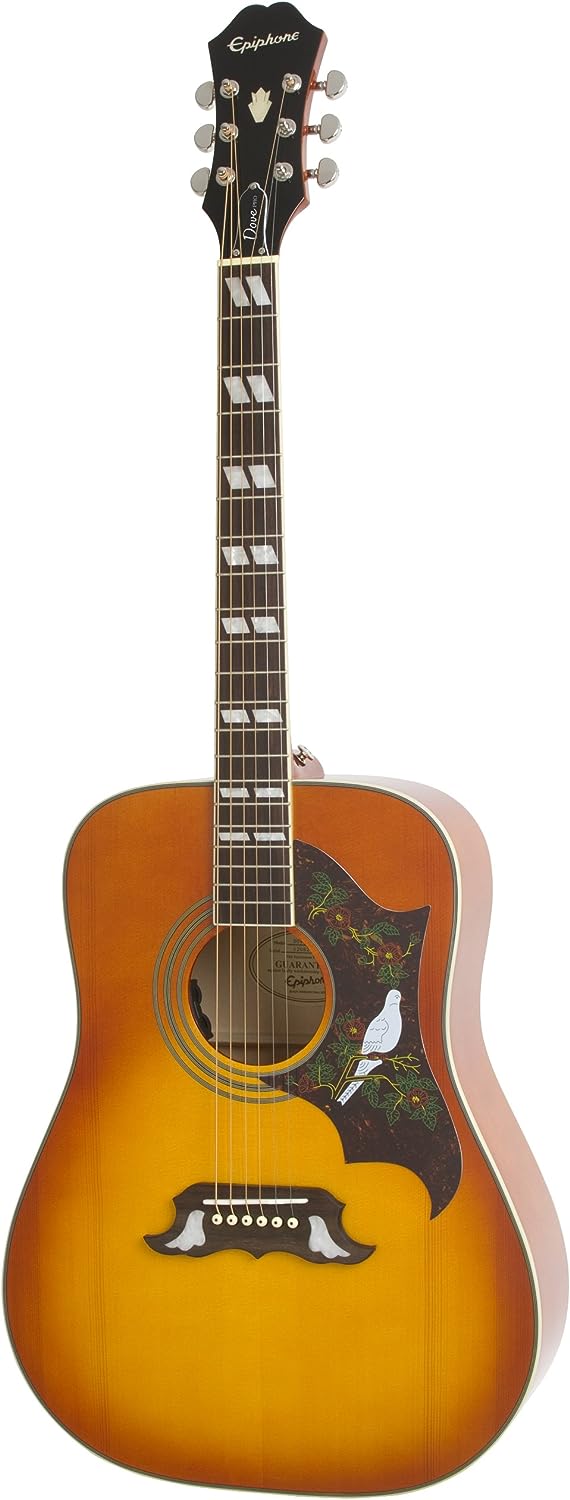
An Epiphone Dove Studio Solid Top Acoustic Electric Guitar in violinburst color is what we’re talking about here.
This elegant instrument features a solid spruce top, giving a rich tonal clarity and superior sound projection.
Complementing the spruce top, the body and neck of the guitar are fashioned from Maple wood, offering both strength and a balanced tone.
Not to forget, the fretboard is crafted from Laurel wood, a popular choice among guitarists thanks to its smooth texture and look.
What sets it apart, though, is the integration of a Sonitone soundhole preamp and Sonicore pickup system from Fishman.
This system comes complete with master volume control and tone adjustment, helping to perfect your sound.
Also, the instrument fits right-handed orientation and is fitted with a fixed guitar bridge system.
A unique attribute to mention here is its Piezoelectric guitar pickup configuration, a feature preferred by many for its ability to produce a clear, full-bodied sound when amplified.
Designed by renowned brand Epiphone, this guitar offers a classic sound that both beginners and professionals would appreciate.
It’s all about providing you with an instrument that is built with undoubtedly high integrity.
- My Review
When I first laid eyes on the Epiphone Dove Studio Solid Top Acoustic Electric Guitar Violinburst, its aesthetic appeal immediately captivated me.
Its Violinburst color was strikingly beautiful and the build quality truly impressed me.
The combination of spruce, maple and laurel wood materials gave it an air of elegance and durability both in feel and appearance.
In particular, the Sonitone soundhole preamp and Sonicore pickup system added impressive tonal qualities that elevated my playing experience enormously.
Adjusting the volume and tone on the guitar was quite straightforward, thanks to the master volume and tone adjustment feature.
Its Piezoelectric pickup configuration made it adept at capturing intricate nuances in my playing, and the right-hand orientation comfortably suited my playing style.
I appreciated the fixed guitar bridge system which provided stability and more precise intonation.
Upon plugging this guitar into an amplifier, I was immediately enveloped by the crystal clear and bright sounds it produced.
Unfortunately, I noticed that the fretboard wasn’t as smooth as some other guitars I’ve tried, which took a little away from the overall playing comfort.
On closer inspection, I did come across some negligible flaws like minimal wear marks on the strings, suggesting that this might not be an entirely brand new unit.
However, a simple string change resolved this minor hitch and the guitar sounded as good as new.
On a brick-wall, my biggest gripe with this guitar is its unbalanced tone when plugged into an amplifier.
This was a bit of a letdown given that the guitar is branded as an acoustic-electric.
I also couldn’t ignore the fact that the guitar was made in Indonesia, although the product description indicated a USA manufacture.
This discrepancy didn’t sit especially well with me as the country of manufacture could influence overall quality and craftmanship.
Nonetheless, considering the price point, this guitar is a worthy investment for both beginners and seasoned players alike, offering a balance of impressive aesthetics, durable construction, and crystal clear sound.
There might be a few hiccups along the way, but nothing that a passionate guitarist like myself couldn’t fix.
All things considered, the Epiphone Dove Studio Solid Top Acoustic Electric Guitar Violinburst has found its place in my collection and I relish each opportunity I get to play it.
- Pros:
- Great sound quality.
- Beautiful product design.
- Comfortable and easy to play.
- Cons:
- Issues with electronics functionality.
- Potential concerns with quality control.
- Product not made in USA.
With features like the Sonitone soundhole preamp and Sonicore pickup system, it provides high-quality sound and versatility.
The use of Maple in the body and neck material ensures durability while the Piezoelectric pickup configuration adds to its impressive performance.
The Violinburst color and Spruce top material contribute to its attractive aesthetic.
Therefore, whether you’re a beginner or a professional, this guitar promises a stellar musical experience.
Seagull S6 Original Acoustic Guitar
North American-made guitar with unique cherry tone.
This acoustic guitar is crafted in North America, with a specially pressure tested top for enhanced quality. It features a unique blend of wild cherry and cedar, providing a distinct tone, with the addition of a Tusq nut and compensated saddle for better intonation. Additional attributes like tapered headstock and specially aligned machine heads aid in precise tuning.
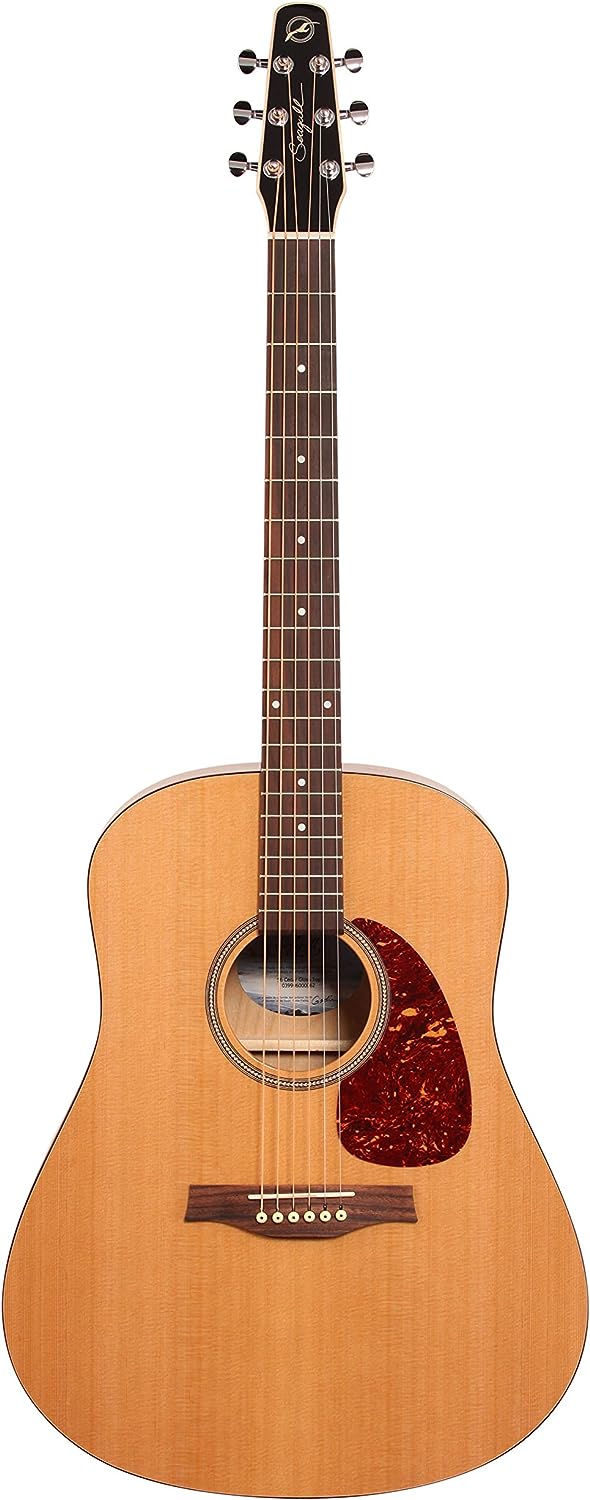
The Seagull S6 Original Acoustic Guitar is a product of outstanding craftsmanship, all made in North America.
This guitar boasts a select pressure tested top, guaranteeing its superior quality.
One of its exceptional features is the double action truss rod, ensuring the longevity and stability of your instrument.
It comes with a tapered headstock, perfect for stable tuning and well-suited for open tunings as well.
The guitar is equipped with a Tusq nut and compensated saddle, offering enhanced intonation for a more accurate sound.
Proudly bearing the Seagull brand, it comes in a natural, eye-catching color.
Made primarily of Cedar and Wild Cherry, the guitar not only looks good but ensures an exceptional tone too.
Additionally, the guitar’s neck is made from Maple while its fretboard is made of Rosewood.
The Seagull S6 Original Acoustic Guitar is right-hand oriented and uses Phosphor Bronze strings.
Furthermore, the guitar uses a Rosewood bridge system, contributing to its already superior quality.
Its wild cherry back and sides, coupled with a solid cedar top, provides a unique blend of warmth and definition.
Lastly, the guitar’s short-scale silverleaf maple neck features a rosewood fretboard that is not only easy on the fingers, but its aligned machine heads also support quick and reliable tuning.
- My Review
From the first touch, this Seagull S6 Original Acoustic Guitar impresses with its exquisite craftsmanship.
Made with a keen eye for detail in North America, its superior quality is undeniable.
Equipped with a select pressure tested top and a double action truss rod, this guitar features components that provide both durability and optimum performance.
The tapered headstock serves as more than a visual treat, offering both precise and stable tuning, which is great for open tunings.
Also worth mentioning is the Tusq nut and compensated saddle which significantly contribute to better intonation.
Now let’s talk about the astounding sound produced by this guitar, the blend of cedar and wild cherry used for the body of the guitar give it a unique tonal quality.
It is well balanced, blending the warmth of mahogany with the crisp definition of maple.
This results in a sound that is not just pleasing to the ears, but also captures the attention of any listener within earshot.
The guitar’s playability factor is another point-earning component.
With its silverleaf maple neck on a shorter 24.84″ scale and a rosewood fretboard, it’s clearly designed to be comfortable for the fingers.
However, bear in mind that the width of the nut/fretboard at the top might feel a bit narrow for some players with bigger hands.
That minor quirk doesn’t reduce the overall worth and prowess of this guitar, though.
On the contrary, this minor condensation towards the top could be a plus for players with smaller hands.
An interesting feature to note is the use of phosphor bronze strings, enhancing the warm tonal quality and overall sound of the guitar.
The design and aesthetics of the guitar ring a bell of timeless charm, with the natural color allowing the materials used in its construction to shine.
Finally, it’s important to note that the semi-gloss finish not only adds to its allure but also provides a comfortable and smooth surface for the player.
All things considered, this Seagull S6 Original Acoustic Guitar stands as a wise investment for anyone seeking a reliable playing partner with great sound.
- Pros:
- Beautiful tone and construction.
- Great playability for beginners.
- Reliable and stable tuning.
- Cons:
- Not consistent in different weather.
- Nut width inconsistency in versions.
- Potential susceptibility to scratches.
My final verdict is that the Seagull S6 Original Acoustic Guitar is a top-notch instrument with remarkable features.
With a blend of wild cherry and cedar, it achieves a unique tone, adding warmth to the sound.
The double action truss rod and the tapered headstock ensures precise and stable tuning, making it ideal for open tunings.
Its high-quality Phosphor Bronze strings and rosewood bridge system contribute to better intonation.
Manufactured in North America, this guitar showcases excellent craftsmanship and is well worth the investment.
Taylor 214ce Plus Grand Auditorium Acoustic-Electric Guitar
Taylors 6-string Acoustic-electric with Spruce Top offers exceptional sound.
This is a beautifully designed 6-string acoustic-electric cutaway guitar with a spruce top and rosewood back. It comes with an ebony fingerboard and a mahogany neck, all enclosed in a natural, powder-coated finish. Moreover, it includes a special AeroCase Gig Bag and operates manually.
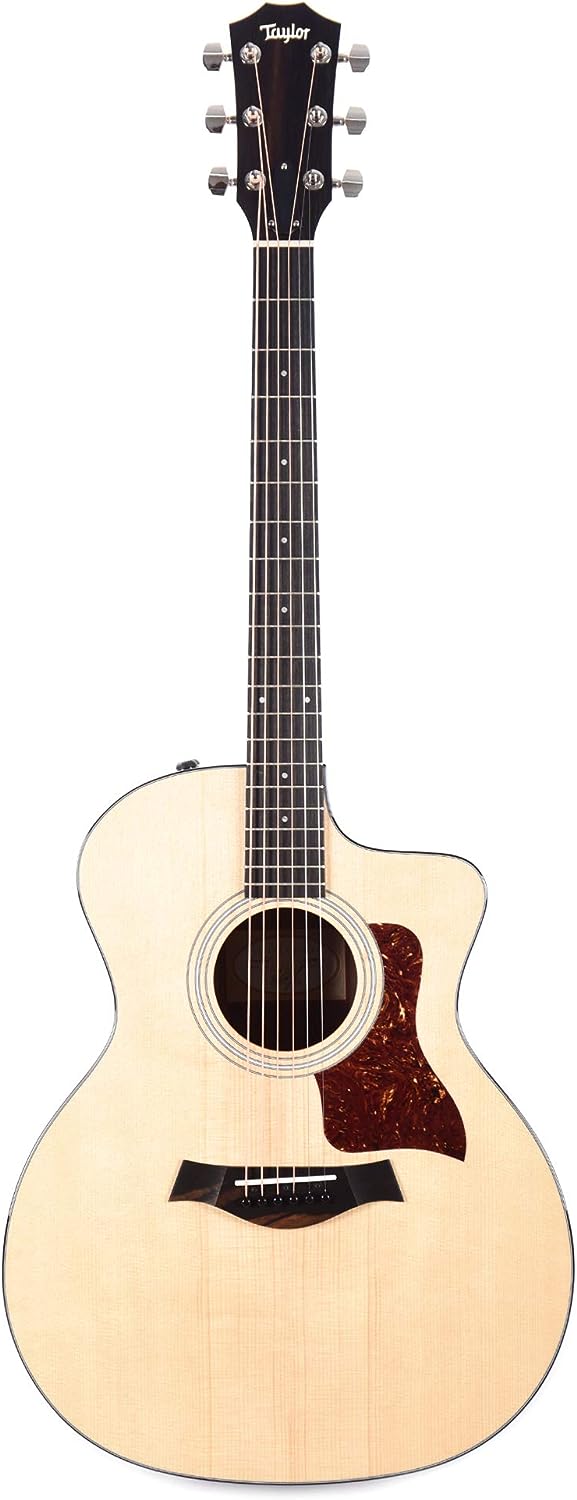
What we have here is the Taylor 214ce Plus Grand Auditorium Sitka/Rosewood acoustic-electric guitar, complete with a gig bag branded with AeroCase.
It’s got this pretty appealing natural color that adds a raw touch to its aesthetic appeal.
Further enhancing its beauty, it features a spruce top with Rosewood back and sides, which also play a vital role in its sound quality.
The neck of the guitar is made from durable and strong mahogany, ensuring you a sturdy hold.
The fingerboard where the magic happens is made of ebony, which adds a touch of elegance and functionality
It’s a standard six-string guitar but not just any, it features phosphor bronze strings known for their superior tonal quality.
The Taylor brand has finished it with a powder coating, providing additional durability and a sleek appearance.
It’s a manual instrument – the strength of the sound relies on the rhythm of your strumming.
To top it all off, its dimensions are a generous 52 x 18 x 8 inches, striking a perfect balance between size and portability.
What that sums up to, is an artfully crafted acoustic-electric cutaway guitar, designed to impress not only with its looks, but also its functionality and sound.
- My Review
Upon experiencing the Taylor 214ce Plus Grand Auditorium Sitka/Rosewood Natural ES2 for myself, I must admit, I was thoroughly impressed.
The acoustic sound of this piece is simply phenomenal, providing a crisp, bright, and well-balanced audio experience that offers great range.
Of course, the charm is not only in its sound but also in its visual appeal.
It graces a gorgeous glossy body that demands attention, no less than what you’d expect from a quality instrument.
Touching on the negatives, some aspects can mar this otherwise exquisitely crafted instrument.
The higher notes require a fair bit more finger pressure to play, possibly causing discomfort for prolonged periods of use.
I also found the look of the guitar to be simply ‘fine’; it doesn’t exactly knock your socks off, but it doesn’t disappoint either.
If aesthetics are a deal-breaker for you, then you might need to place the sound quality over the physical requirement.
Considering the travel case that accompanies the guitar, it does provide solid protection but its quality is noticeably lower than that of the instrument itself.
There’s a slight ‘cheap’ feel to it, with some issues like the rough finish on the inside and pins sticking out the bottom of it.
I appreciate that the packaging it arrived in could have been better, especially for such an exceptional and high-value item.
Despite its shortcomings, the instrument itself is a solid piece that offers world-class performance.
The guitar arrives with a set-up that is near perfect, allowing you to play it persistently from the moment it’s out of the box.
One major positive is the transparent and responsive electronics that are simple to use, adding to the overall hassle-free experience.
In spite of the negatives, the Taylor soundbox really stands out for its unique, clear tone and easy to use functionality.
I must emphasize that the value you get from the sound quality far outweighs the setbacks of its aesthetics and the quality of the accompanying case.
I encourage anybody deliberating over this purchase to consider the outstanding tone and unparalleled performance above all else.
- Pros:
- Loud, bright and balanced sound.
- Perfect action and intonation.
- Comes with an AeroCase gig bag.
- Cons:
- Needs to press hard for higher notes.
- Case interior appears cheaply made.
- Mediocre external design.
My final verdict is that the Taylor 214ce Plus Grand Auditorium Sitka/Rosewood Natural ES2 w/AeroCase Gig Bag is a top-tier guitar for both professionals and hobbyists alike.
Its acoustic-electric feature coupled with its spruce top and rosewood back sides make it a versatile, rich-sounding instrument.
The inclusion of a phosphor bronze string is an exemplary specification that enhances its already outstanding music output.
Its AeroCase Gig Bag offers convenience and portability, making it perfect for musicians on the go.
Considering its remarkable features and superior sound quality, it represents excellent value for the price.
Takamine GD-20 NS Acooustic Guitar
Guitar offers great playability with superior intonation.
This right-handed acoustic guitar offers a unique sound blend with its solid cedar top and mahogany back and sides. It features a slim satin-finish mahogany neck and 12″-radius rosewood fingerboard for smooth playability. It also includes a synthetic bone nut, bridge saddle for superior intonation, and a natural satin finish for a touch of elegance.
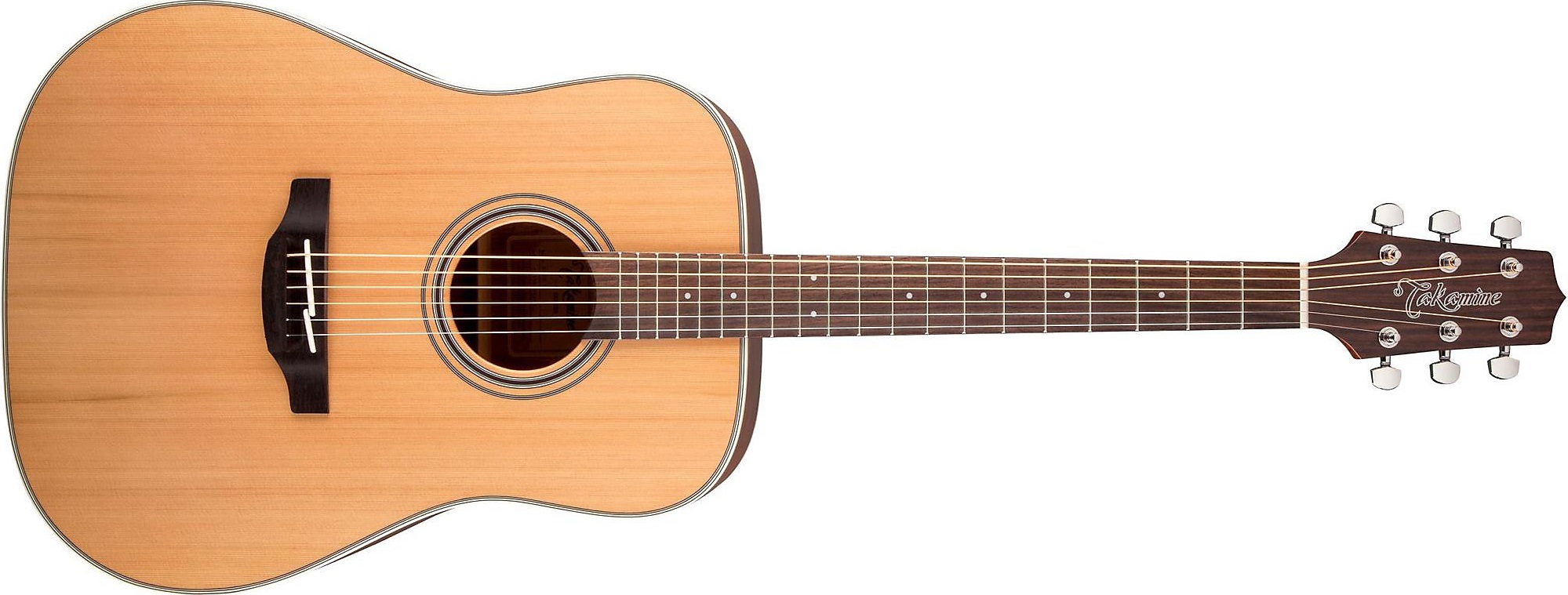
The Takamine 6 String Acoustic Guitar (GD20-NS) is specifically designed for right handed players and flaunts an elegant Natural satin finish.
Constructed with a solid cedar top and mahogany back and sides, this guitar not only looks good but also produces a distinctively warm and detailed tone.
Its slender mahogany neck has a satin-finish, coupled to a 12″-radius rosewood fingerboard, ensuring a great playing experience.
A unique feature of the GD20 is the responsiveness and clear resonance provided by its split-saddle, pin-less rosewood bridge.
This design of the bridge ensures that you can churn out sweeter sounding chords and single-note runs with high-quality intonation.
The Takamine GD20 includes a bone nut and bridge saddle, enhancing the overall pitch accuracy and resonance.
The richly hued rosewood headcap, pearloid dot inlays, and chrome die-cast tuners add to the aesthetic appeal of this versatile guitar.
Lastly, the guitar utilizes a piezoelectric pickup configuration and is strung with nylon strings, ensuring that it can cater to a wide variety of musical genres.
- My Review
Upon first glance, I was struck by the simplistic elegance of the Takamine 6 String Acoustic Guitar, embodied in its natural satin finish.
It’s undeniable that the choice of cedar for the top material gives this guitar a sturdy, dependable feel.
Featuring a mahogany back and sides, the GD20-NS successfully merges durability and lightweight for an effortless playing experience.
This guitar surprised me with the richness of its tone, a credit to the effective combination of cedar and mahogany.
Notably, the GD20-NS’s
Effortlessly strum chords or glide through single-note runs and enjoy the superior intonation facilitated by the split-saddle design of the pin-less rosewood bridge.
Another element that elevates this guitar is the inclusion of a bone nut and bridge saddle.
Whilst I greatly appreciate the string-thru saddle for its convenience, I couldn’t help but notice the lack of a guitar strap button on the neck and the slightly shaky tuners, which I later replaced with stronger versions to help maintain the guitar’s tuning.
Despite these minor issues, the Takamine GD20-NS continues to impress with a synthetic bone nut and a rosewood headcap which tie into its overall aesthetic.
Something I feel deserves particular attention is the quality of its sound, as it ring clear even under heavy strumming.
It’s interesting to note that the thickness of the cedar top seems to be a significant factor in ensuring clarity even in intense performances.
The string material is nylon, which provides a softer touch and warm tone, perfect for those wanting to experiment with different styles of play, like fingerstyle or classical guitar.
When it comes to the price point, it’s certainly worth mentioning that this guitar delivers value far beyond its cost, standing on par with high-end guitars that demand triple the price.
In my opinion, both novices and seasoned guitarists would find the GD20-NS a worthwhile investment, offering a fresh spin on a timeless classic while not compromising on function or form.
Although this guitar does not have a cutaway, which I initially missed for better fret access, it didn’t impinge on the overall playability of the instrument.
The Takamine GD20-NS is a well-crafted instrument that brings a sound and craftsmanship that shines brightly among a market saturated with average acoustics.
The bounty of positive features, from its quality tonewood pairing to its well-thought-out hardware layout, make it a guitar I would most certainly opt to purchase again.
- Pros:
- Excellent quality for the price.
- Clear and rich sound production.
- Durable and sturdy build.
- Cons:
- Weak tuners.
- Lack of guitar strap button.
- Might go out of tune.
My final verdict is that the Takamine 6 String Acoustic Guitar is an excellent choice for both beginners and advanced players.
With its solid cedar top and mahogany back, it provides a warm, detailed tone perfect for a wide range of musical styles.
The slim satin-finish mahogany neck and 12″-radius rosewood fingerboard offer great feel and playability, making it a joy to play.
The split-saddle design ensures superior intonation for sweeter-sounding chords and single-note runs.
This guitar offers quality, value, and versatility in a beautiful package.
Epiphone Masterbilt Frontier Acoustic-Electric Guitar
Solid Sitka Spruce top with true acoustic tone.
This electric acoustic guitar recreates an iconic Epiphone classic with a solid Sitka Spruce top, ‘Rope and Cactus’ pickguard, and bone nut. It’s designed for right-handed players and features 20 medium jumbo frets with a 25.5-inch scale for perfect tonality. Owners will appreciate the Fishman Sonitone Onboard Preamp System for genuine acoustic tones when plugged in.
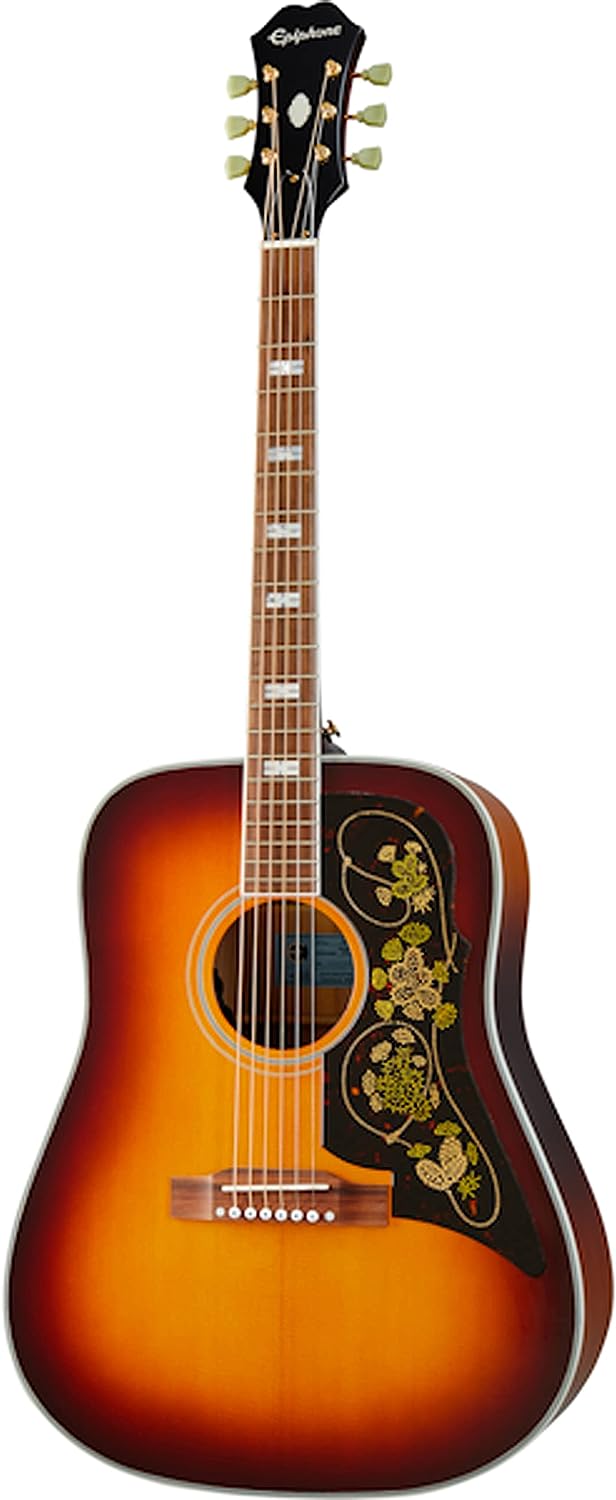
The Epiphone Masterbilt Frontier Acoustic Electric Guitar comes in a visually stunning iced tea aged gloss finish.
Featuring a generous 12-inch radius, secure 1.69-inch bone nut, and a 25.5-inch scale, this guitar offers superior playability.
The guitar is topped off with 20 medium jumbo frets that provide comfortable finger work and chording.
Adding to its robust sound quality is a solid Sitka Spruce top, which not only looks striking, but also significantly enriches the overall tonal depth and resonance.
The guitar’s body and neck are also constructed from Sitka Spruce while the fretboard is composed of Rosewood, ensuring durability and resonance.
Designed for right-handed players, it accommodates all styles and genres.
The 6-string guitar is a nod to traditional designs, making it an authentic and timeless instrument.
Standing out as a notable feature of this Epiphone guitar is the “Rope and Cactus” pickguard design which offers a unique aesthetic appeal.
Furthermore, it’s equipped with the Fishman Sonitone Onboard Preamp System that manifests a true acoustic tone when you plug in.
Lastly, this Epiphone model bears the legacy of the company’s iconic acoustic guitars of the 60s, while incorporating old-school Masterbilt techniques in its making, a clear reflection of Epiphone’s ongoing commitment to acoustic precision and quality.
- My Review
The Epiphone Masterbilt Frontier Acoustic Electric Guitar makes an immediate impression with its stunning Iced Tea Aged Gloss finish.
I found the unique “Rope and Cactus” pickguard to be particularly intriguing, adding a distinctive touch to the instrument’s aesthetic appeal.
Functionally, it doesn’t disappoint either, with the 12” radius ensuring comfortable and effortless hand positioning.
The guitar features a 1.69” bone nut, which is widely recognized for its ability to enhance tone and sustain.
Moreover, the 25.5” scale is a standard length for most guitars, comfortable for both beginner and experienced players alike.
Twenty medium jumbo frets provide ample space for expressing one’s musical creativity and versatility.
The guitar’s Solid Sitka spruce top is noteworthy because spruce is a high-quality, tonally superior wood.
As for the body material, it also consists of solid Sitka spruce, adding to the overall resonance and clarity of sound.
The neck, in keeping with the body, boasts quality spruce wood, resulting in an enjoyable playing experience.
Notable is the rosewood fretboard which ensures a smooth touch and contributes to the rich, warm tonal quality of the instrument.
A thoughtful design aspect is the right hand orientation, which caters to the vast majority of players.
Now, we come to the most significant part for many, the Fishman Sonitone Onboard Preamp System.
Being able to achieve true acoustic tone when plugged in is a real game-changer and catapults this guitar’s value and performance to new heights.
For those who are concerned about the number of strings, rest easy, as the guitar has the standard six strings.
After playing on this guitar, it’s clear why the Masterbilt series pays homage to Epiphone’s iconic acoustic guitars.
But it’s not just about satisfying nostalgia – this guitar’s expert design and high-quality materials also ensure that it delivers in terms of modern functionality and sound quality.
I’d say that playing the Epiphone Masterbilt Frontier Acoustic Electric Guitar is a genuinely invigorating and satisfying experience.
It mixes vintage charm with modern ingenuity gracefully, all the while maintaining an impressive level of performance and sound quality.
Whether you’re a beginner or a professional guitarist, I believe you’d enjoy the sonic possibilities that this beautiful instrument offers.
- Pros:
- High quality build.
- Features attractive design.
- Well-suited for right-handers.
- Cons:
- No significant negatives were found.
My final verdict is that the Epiphone Masterbilt Frontier Acoustic Electric Guitar is a fantastic choice for both professionals and enthusiastic beginners.
Its Solid Sitka Spruce top and unique “Rope and Cactus” pickguard design lend both style and a remarkable quality to its sound.
The Fishman Sonitone Onboard Preamp System ensures excellent acoustic tones when plugged in, perfect for live performances or studio work.
Finally, the guitar’s construction holds true to old-world Masterbilt techniques, indicative of its solid durability and exquisite craftsmanship.
This guitar offers quality, style, and functionality in one lucid package, and I would highly recommend it to any passionate guitarist.
Taylor 100 Series 2017 114e Grand Auditorium Acoustic-Electric Guitar
High-quality, accessible acoustic-electric guitar for all players.
The Taylor Acoustic-Electric Guitar is a high-quality instrument with a major emphasis on sound and durability. It boasts a solid Sitka spruce top, layered walnut back and sides and a sapele neck, all contributing to incredible volume and dynamics. Furthermore, its unique ES2 pickup design aids in premium sound amplification, making it perfect for both beginners and experienced players alike.
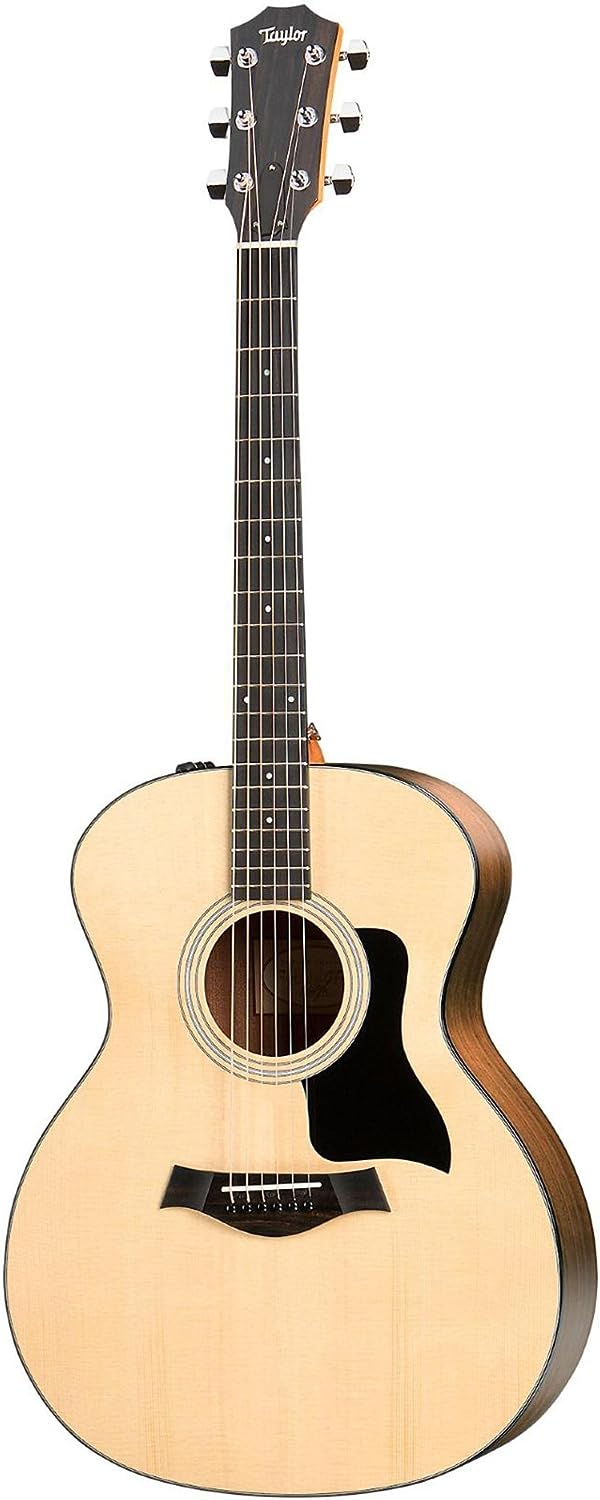
The Taylor 100 Series, 114e Grand Auditorium Acoustic-Electric Guitar is a premium instrument that boasts of a stunning natural finish.
It features an auditorium size body with a single cutaway, providing better access to the higher frets for slide players or soloists.
The top is made from Solid Sitka Spruce while the back and sides are layered with high-quality Walnut, resonating a rich and robust sound.
The guitar has a unique bracing pattern, known as the Taylor Standard II Bracing (Forward Shift Pattern) which adds to its sound dynamics.
A matte 2.0 varnish serves as the body finish, enhancing the overall aesthetic of this right-handed guitar.
The neck of the guitar has been carved from Sapele wood and follows the standard Taylor Profile.
On the neck lies a genuine African Ebony fingerboard having a nut width of 1-11/16 in. and a scale length of 25-1/2 in.
This model facilitates enhanced playability, hence, it can be an ideal companion for those individuals who are either just beginning their musical journey or are looking to make significant strides.
The neck profile of Taylor, coupled with a convenient nut width, makes forming barre chords easy, particularly for developing players.
The Grand Auditorium body style promises an abundance of volume in response to light fingerpicking and offers a clear, balanced sound across the tonal spectrum when subjected to medium strumming and flatpicking.
The guitar top, made from prevalent Sitka spruce, serves as the main filter and distributor of the vibrating string energy, thereby having a substantial impact on the sound.
This Taylor 100 series model also includes a durable, 600-denier nylon gig bag with double-stitched seams and reinforced stress points, enhancing convenience for those who frequently travel with their instruments.
The innovative design from Taylor’s patent, ES2, or Expression System 2, forms the pivotal part of Taylor’s continual innovation in acoustic guitar amplification.
From the behind-the-saddle pickup, sound vibrates through the body of the guitar, thereby delivering a revolutionary acoustic experience.
- My Review
When I first laid my hands on the Taylor 100 Series 114e Grand Auditorium Acoustic-Electric Guitar, I was immediately struck at the inherent craftsmanship at display.
The Sitka spruce top wood, combined with layered walnut on the exterior, gives the guitar a natural and aesthetically pleasing touch.
It also boasted a sturdy and comfortable grip, thanks to the cutaway design and the right-handed orientation which adds to the comfort and convenience.
The Taylor Grand Auditorium cutaway had a unique design appeal to it, that was both purpose-oriented and visually distinct.
Being a keen observer of musical instruments, the neck profile of this guitar caught my attention.
Constructed from sapele, it featured a standard Taylor profile with a nut width of 1-11/16 in.
This thoughtful touch greatly enhanced the ease of forming barre chords, thereby improving the overall playing experience.
Yet, it’s not just the design and build quality that had me impressed.
With the Taylor 100 series, I found, one gets an exceptional guitar-playing experience that’s accessible, enhanced by the instruments’ promise to accelerate players’ growth and enjoyment.
With the layered walnut backs and sides and the new architecture, the sound output of this guitar hit all the right notes in my ears, sounding dynamic across a vast range.
The tonal spectrum on this beauty was impressively broad, managing to vividly react to varying strumming intensity, from light fingerpicking to medium flatpicking.
Beyond the sound and design, the innovation in acoustic guitar amplification involving Taylor’s ES2 pickup also deserves a special mention.
This revolutionary design comprises a behind-the-saddle pickup that serves to elevate the overall playability and enjoyment of the guitar, making it an excellent choice for both beginners and seasoned players.
That being said, I did come across a minor aesthetic flaw – a slight crack where the neck meets the body.
However, this did not impact the sound quality or the overall structural integrity of the Taylor 100 Series 114e Grand Auditorium Acoustic-Electric guitar.
This guitar not only manages to look good but also packs in quite an audible punch with its excellent sound output and dynamic range.
- Pros:
- Excellent build quality and sound.
- Heightens player’s playability and enjoyment.
- Includes a durable gig bag.
- Cons:
- Possible issues with initial action setup.
- Minor aesthetic issues reported.
- Size may be smaller than expected.
My final verdict is that the Taylor 100 Series 2017 114e Grand Auditorium Acoustic-Electric Guitar is an exceptional instrument for both beginners and advanced players.
The real wood construction and Sitka spruce top guarantee a high-quality sound and a great playing experience.
With its generous volume and dynamic tonal spectrum, this guitar is versatile for any style of play.
The additional durability from the layered walnut back and sides also make it an excellent choice for those who travel with their instruments.
The value and performance offered by this Taylor guitar absolutely justifies the investment.
Epiphone Hummingbird Studio Acoustic-Electric Guitar
Quality build with excellent electronics and aesthetics.
This guitar boasts a solid spruce top, mahogany neck, and body with a rosewood fretboard, designed in an appealing faded cherry color. It features Grover Rotomatic tuners and a hummingbird pickguard, ensuring optimal performance and good looks. With Fishman Sonitone electronics and a piezoelectric pickup configuration, it offers high-quality sound production.
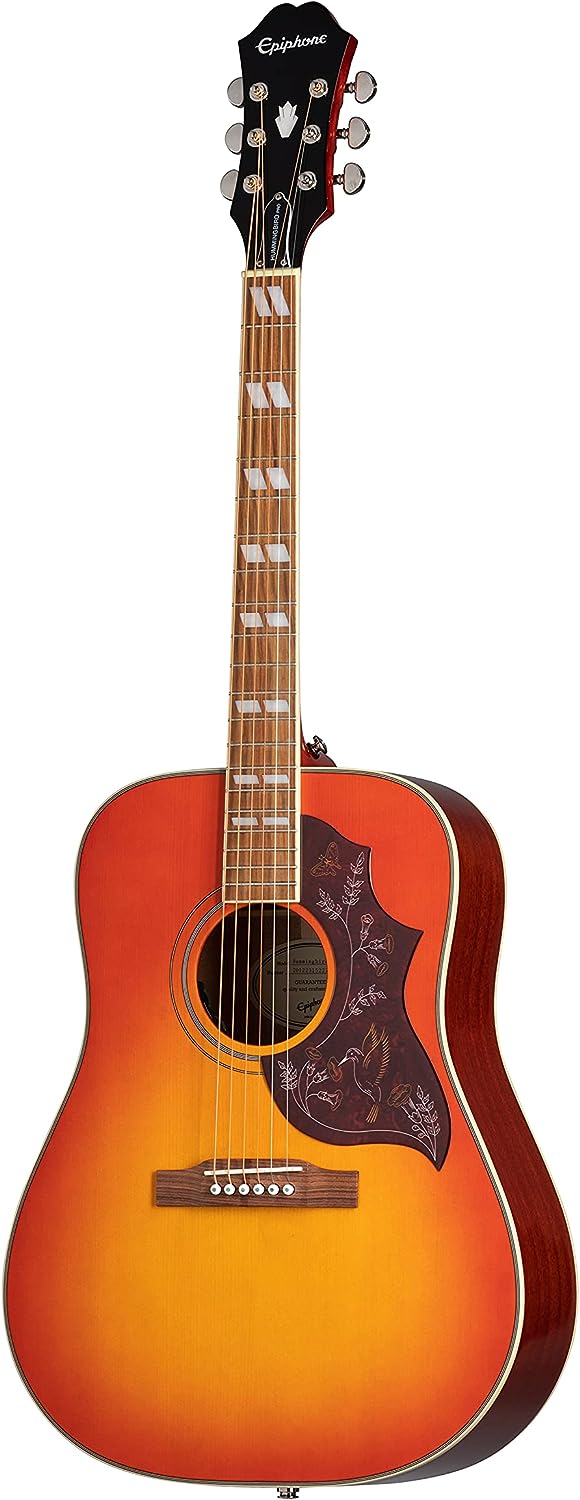
The Epiphone Hummingbird Studio Acoustic/Electric Guitar stands out due to its rare blend of stunning aesthetics and functionality.
This masterpiece comes with a solid spruce top, renowned for durability and delivering beautiful, rich sound.
The body is of Mahogany, an excellent choice not just for its appealing look, but also for its resonance and warmth, enhancing the overall sound output.
Interestingly, this guitar also features a neck made of Mahogany, complementing the body perfectly and adding to the harmonious tonal output.
You will certainly enjoy the pre-installed Fishman Sonitone electronics, which provide state-of-the-art sound processing capabilities, allowing guitarists to fine-tune the output to their liking.
In an elegant touch, the guitar is adorned by a charming Hummingbird pickguard, a subtle nod to its name and nature.
Tuning stability and precision are ensured by the Grover Rotomatic tuners integrated into this piece.
The guitar sports a Faded Cherry color, infusing it with an irresistible vintage appeal.
As for its built features, it includes a Rosewood Fretboard, a popular choice for its smooth texture and fantastic playability.
This guitar has been designed for right-hand players, with an efficient Fixed Bridge System and a Piezoelectric pickup configuration.
The Epiphone brand confirms the quality, as it’s a trusted manufacturer in the realm of musical instruments.
- My Review
As a guitar enthusiast, I am genuinely impressed by the Epiphone Hummingbird Studio Acoustic/Electric Guitar.
From its appearance, it certainly is a thing of beauty. The faded cherry color gives it a vintage appeal, while the hummingbird pickguard adds a distinctive touch.
When it comes to its construction, its mahogany neck and body lend significant durability and resilience, underlying the focus on quality.
The solid spruce top seems indispensable in providing a balanced and rich tone.
One of the guitar’s inherent strengths lies in the Fishman Sonitone electronics.
These work to amplify the tone without distorting the natural acoustic sound.
Remarkably, the guitar comes with Grover Rotomatic tuners, which over the years have proven to offer outstanding tuning stability for any guitar player like me.
Another noteworthy aspect is that this guitar features a fixed guitar bridge system and a rosewood fretboard, making it friendly to any player’s style and preference.
The piezoelectric guitar pickup configuration is also a significant feature that enhances its tonal potential.
From my personal testing, the sound quality is undeniably bright and vibrant, quite surprising to expect from an affordable guitar like this.
Moreover, the light strings installed on this guitar gives a comfortable playability out of the box.
One must not overlook the comfortable neck size, which is extremely easy on the hands, enabling a variety of chords to be played with ease.
These features make it perfect not just for me, but for smaller frame performers as well, such as women and aspiring young guitarists.
However, no product is free from flaws, and the same applies to the Epiphone Hummingbird Studio Acoustic/Electric Guitar.
One might find the action a bit high on the upper frets, suggesting the necessity for a professional setup for optimum playability.
A few users might also experience a buzz after standard tuning, which could be a minor setback in an otherwise versatile instrument.
And yet, even with a few cons, I strongly believe that it is a commendable instrument for its price point, providing excellent value.
All told, the Epiphone Hummingbird Studio Acoustic/Electric Guitar is a delightful blend of attractive design, skillful construction and favorable sound, making it a wonderful addition in any guitarists’ ensemble.
- Pros:
- Easy to play with good action.
- Quality electronics and clear sound.
- Beautiful design and finish.
- Cons:
- Some units have manufacturing flaws.
- Pickup problems reported by some users.
- High E string can be too quiet.
My final verdict is that the Epiphone Hummingbird Studio Acoustic/Electric Guitar stands as a superior choice for both amateur and professional players.
With the Solid spruce top and Mahogany neck and body, it delivers excellent sound quality and durability.
Moreover, the Grover Rotomatic tuners and Fishman Sonitone electronics ensure top-notch performance and versatility.
The Faded Cherry color and the iconic Hummingbird pickguard give it a classic and captivating appearance.
In view of all these features, it is certain that the product delivers value worth its price.
Fender CD-140SCE Dreadnought Cutaway Acoustic Guitar
Robust tone, perfect for any playing style.
This acoustic guitar, in sunburst color, has a single-cutaway dreadnought body style crafted from solid spruce and Ovangkol. It features a comfortable, easy-to-play neck and superior Fishman CD preamp. The package includes a robust hard-shell case for secure storage and transportation.
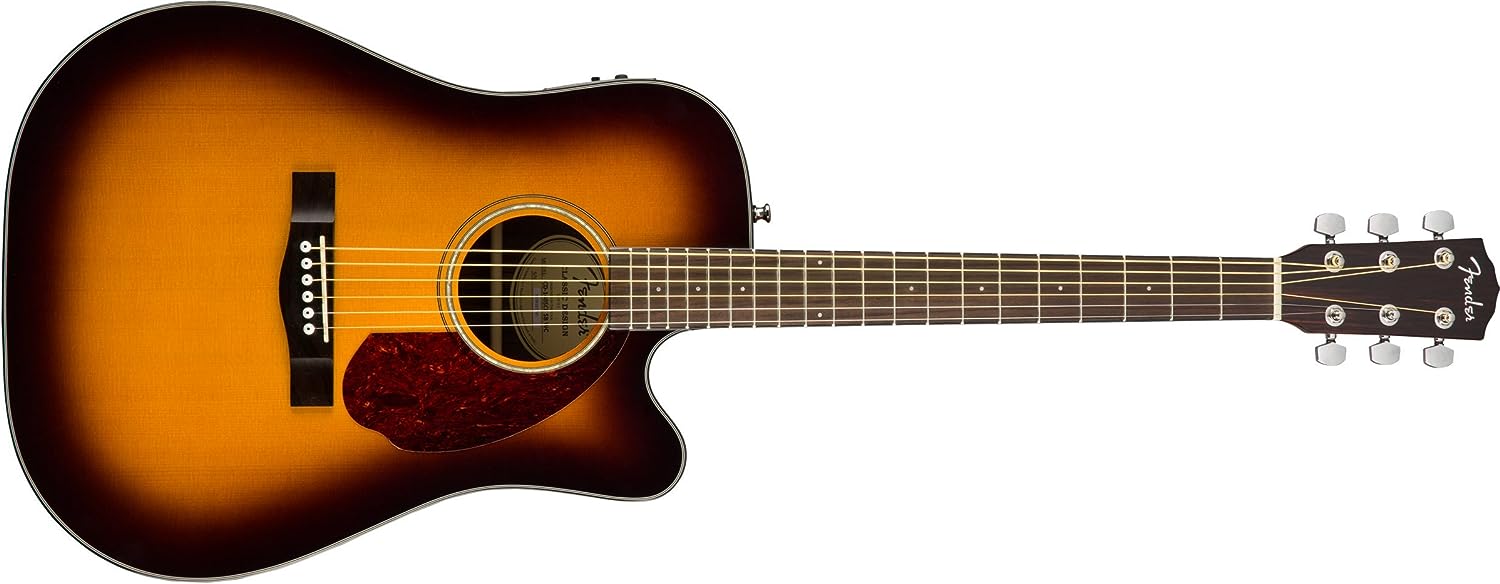
This Fender CD-140SCE is a dreadnought acoustic guitar complemented by a cutaway design in a radiant Sunburst color, which also comes with its hardshell case.
It boasts a solid spruce top outfitted with scalloped ‘X’ bracing to ensure sturdy construction and lends the guitar a robust tone.
This guitar is crafted with ovangkol used both for the back and the sides of the body, which enriches the instrument’s overall resonance and tone.
It features an easy-to-play neck design having rolled fingerboard edges which makes it comfortable for players of all styles.
This model is equipped with the impressive Fishman CD preamp, promoting dynamic and well-rounded tones.
The CD-140SCE also comes with – a crucial feature for many – a right-handed hand orientation.
Manufactured under the reputed brand Fender, this guitar is refined with Spruce wood neck and a Walnut wood fretboard.
It has a Piezo pickup configuration and the strings are made from Nickel Steel.
Among its visual features, it has a charming tortoiseshell pick guard and a sleek walnut headcap.
This instrument is versatile and ready to deliver impressive performances both at home and on stage.
- My Review
I took notice of the Fender CD-140SCE Dreadnought Cutaway Acoustic Guitar‘s single-cutaway dreadnought body style first off.
It offers a solid spruce top equipped with scalloped “X”-bracing and ovangkol back and sides which all worked together to provide a robust tone.
I can’t downplay the significant role the easy-to-play neck with rolled fingerboard edges played in promoting an enjoyable playing experience, truly a delight to many players.
Bearing in mind its construction, I also noticed the Fishman CD preamp, which works great, adding more value to the instrument.
In terms of orientation, it’s right-handed, making it a suitable go-to for most players.
What really got me was the sturdy hardshell case it comes with, providing a handy storage option and ensuring the guitar’s safety during transportation.
When you look at the sunburst color, it’s absolutely gorgeous, capturing a beautiful classic feel.
Its body and back materials made of ovangkol, topped by a solid spruce wood neck, and fretboard made of walnut wood, all contribute to its overall sturdy, durable structure and excellent tonal quality.
Additional features include the piezo guitar pickup configuration and nickel steel strings that enhance its acoustic performance.
The guitar’s overall aesthetics including a tortoiseshell pick guard and walnut headcap are impressive, giving it that professional look, making it a stare-evoking masterpiece both on and off the stage.
Let’s not forget the delightful sound this guitar makes, it’s rich and clear, confirming the value of a solid top.
However, there’s a slight drawback; the action seems somewhat high around the higher frets which could require some getting used to or even a professional setup.
There’s a small problem with the preamp controls though, the tiny knobs for volume, bass, and treble are quite hard to use, given they’re quite small and it’s hard to see how much you’ve adjusted them.
Even with that said, I still maintain that this guitar holds a bargain considering its remarkable sound, pleasing aesthetics and quality of construction.
From my understanding, it’s a lovely guitar perfectly tailored for a variety of playing styles with an excellent balance between value and performance.
- Pros:
- Beautiful and high gloss finish.
- Quality tone and sustain.
- Comes with hardshell case.
- Cons:
- Potential fretboard issues.
- Action may be high on higher frets.
- Frequent fret buzzing reported.
My final verdict is that the Fender CD-140SCE Dreadnought Cutaway Acoustic Guitar is a top-tier product that offers superb value.
Its solid spruce top and ovangkol back and sides deliver unmatchable robust tones, suitable for all musical styles.
The easy-to-play neck covered with rolled fingerboard edges appeals to both beginners and experienced guitarists alike.
Moreover, the Fishman CD preamp and included hardshell case add impressive value, making it a worthwhile investment.
Its impeccable quality and features undoubtedly uphold Fender’s trusted reputation in the guitar industry.
Yamaha A5R ARE Dreadnought Cutaway Acoustic-Electric Guitar
Handmade Acoustic-electric with Vintage Vibe, Big Voice.
This acousto-electric guitar features a solid Sitka spruce top, mahogany neck, embodied in a vintage natural finish. It boasts a solid rosewood back and sides with an ebony fingerboard, complemented with a piezo pickup configuration. Delivering a big voice, it’s handcrafted to exude a vintage vibe and is ideal for right-handed players.
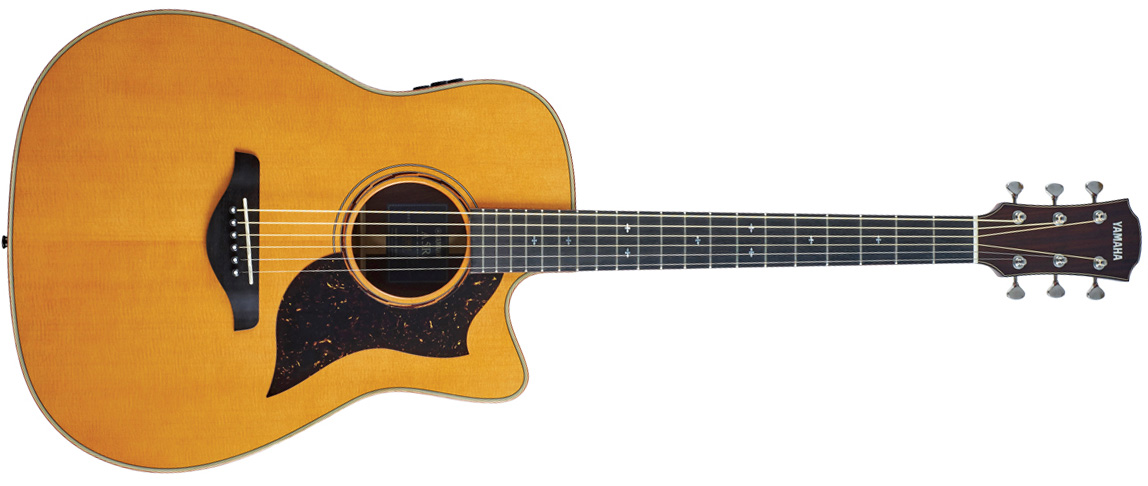
We’re discussing the Yamaha A5R ARE Dreadnought Cutaway, designed with a unique vintage natural finish.
This is a 6-string acoustic-electric guitar, making it incredibly flexible in a variety of musical situations.
The top layer is made of solid Sitka spruce, a premium material renowned for its rich sound.
Complementing the top, the back and sides are comprised of solid rosewood, which adds depth and warmth to the guitar’s overall tone.
To improve comfort and playability, the guitar features a neck crafted from mahogany.
A defining attribute of this guitar is its ebony fingerboard offering a smooth playing experience.
As for the brand, it’s Yamaha, a world-recognized name in terms of producing quality musical instruments.
The guitar’s color can be best described as vintage natural, a timeless choice that allows the grain of the wood to shine through.
Furthermore, the guitar has a built-in piezo pickup system for amplification purposes.
Last but not least, it’s important to note that this guitar is configured for right-hand orientation.
This guitar is a handmade acoustic-electric model that perfectly combines a vintage, yet modern feel with a powerful tone.
- My Review
Stepping into the world of top-tier acoustic guitars, I decided to give the Yamaha A5R ARE Dreadnought Cutaway a spin.
To my surprise, the artistry of Yamaha was clearly displayed in this instrument.
Firstly, I was immediately taken by the vintage natural finish which set a distinctive tone.
Tucked beneath this beautifully aged look, lies a Solid Sitka Spruce top, a clear signal of Yamaha’s commitment to quality and sound perfection.
When I strummed the strings for the first time, the sound produced was deep, full-bodied and rich in texture.
My fingers glided effortlessly across the smooth ebony fingerboard.
The action was set incredibly low, and I noticed zero buzz, leaving my playing unhindered by any unwanted noise.
The fact that the Mahogany neck was so perfectly carved spoke volumes about the overall craftsmanship.
The Rosewood body was just as eloquently crafted showing off the traditional Yamaha acoustic guitar design, while the texture of the back side, made from the same material, was beautifully finished adequate to appeal to any discerning musician.
Shifting my attention to performance, when plugged in, I sensed the guitar’s electronics were top-notch.
Renowned for its Piezo pickup configuration, I found its sound emission to be consistently clear, without any distortions or feedback.
Further, I appreciated the hand orientation since it supported a right-handed configuration, providing a comfortable playing experience.
A closer look revealed the string material to be bronze, a quality detail ensuring durability and sustain.
Even though this guitar has a solid presence instrument array, it surprisingly didn’t feel heavy, a testament to its well-constructed design.
This guitar isn’t just an instrument, it has its own personality that resonates with every strum and every note I played.
While the overall aesthetics are undoubtedly pleasing, the true essence of the Yamaha A5R ARE Dreadnought really lies in the sound—its beautiful melody, deep resonance and clarity.
The guitar didn’t just sound good, it felt great!
Playing it felt like I was engaging with a long-standing tradition of music-making.
This guitar, its construction, its design, its sound, all resonates with the heart and soul of the art of acoustic guitar performance.
- Pros:
- Excellent sound and intonation.
- Durable and solid build.
- Value for money.
- Cons:
- No significant negatives were found.
My final verdict is that the Yamaha A5R ARE Dreadnought Cutaway – Vintage Natural is a top-tier guitar constructed with premium materials that provide a distinct and rich sound.
With its Solid Sitka Spruce Top and Mahogany neck, this guitar is not only visually striking, but resonant and enduring.
The combination of the rosewood back and sides with a piezo pickup configuration enhances the depth of tone, making this guitar ideally suited for a variety of styles.
Investing in this guitar will provide you with a singular musical experience, an instrument that reflects Yamaha’s commitment to quality and craftsmanship.
Whether you’re an amateur musician or a seasoned pro, I highly recommend this acoustic-electric marvel.
Washburn Festival EA15 Mini Jumbo Cutaway Acoustic-Electric Guitar
Quality acoustic-electric guitar with superior craftsmanship.
This acoustic-electric guitar is part of Washburn’s Festival series, designed specifically for performing musicians and featured on MTV’s “Unplugged”. Equipped with Barcus Berry electronics and a cutaway for reaching upper frets, it boasts a comfortable mini jumbo shape, ideal for smaller players or those seeking a more focused sound. The Ice Tea Burst gloss finish highlights the natural beauty of its Figured Maple top.
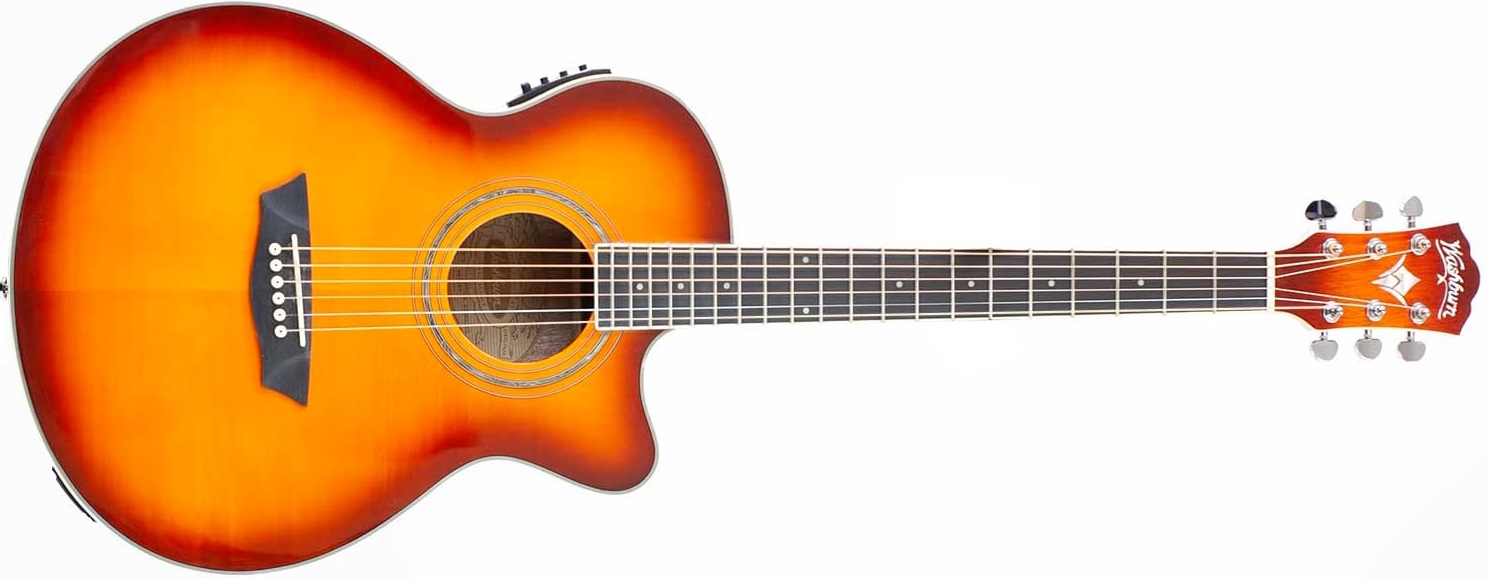
The Washburn Festival EA15 Mini Jumbo Cutaway is an acoustic-electric guitar steeped in Washburn’s long-standing history of crafting superior instruments.
Featuring a distinctive design that caters to performing artists, this guitar was a regular feature on MTV’s iconic “Unplugged” series, earning it the status of a bestseller and role model for many subsequent models.
One noteworthy facet of this guitar is its comfortable mini jumbo cutaway body, perfect for those who might find larger dreadnought or grand auditorium-shaped guitars difficult to handle.
This shape is ideal for younger learners, smaller players, or musicians who prefer the intimate voice of a small-bodied guitar. The scale measures 25.5.
Barcus Berry electronics equip this guitar, boasting a pre-amp, pickup, and a variety of features like an onboard tuner, EQ controls, and resistance to feedback.
Aesthetically, the guitar shines in an Ice Tea Burst gloss finish, accentuating the natural beauty of its figured maple top with a warm, honey-esque touch.
Finally, the product’s specifications reveal a guitar crafted from a selection of high quality materials, including a maple wood top, catalpa back, and mahogany neck, with a right-hand orientation.
- My Review
I must say, playing the Washburn Festival EA15 Mini Jumbo Cutaway, Acoustic Electric Guitar was indeed a joy.
When I first held it, what struck me was the comfort of the Mini Jumbo Cutaway design.
It feels particularly easier to play especially for individuals who might find the large dreadnought and grand auditorium shapes a bit uncomfortable.
One can easily sense that it’s well suited for smaller players, young learners or active musicians looking for the focused, intimate voice that a small bodied guitar can provide.
Plugging it in was a breeze thanks to the pre-equipped Barcus Berry Electronics.
With features like an onboard tuner, EQ controls and feedback resistance, you’re absolutely ready from the get-go.
Looking at the gloss-finished body, the Ice Tea Burst was indeed an eye-catcher.
This warm, honey colored treatment accentuates the natural beauty of the wood and the Figured Maple top was simply a treat to look at.
Design aesthetics aside, when I strummed the strings for the first time, I noticed that the sound quality was incredibly high.
The crystalline highs blend perfectly with a full, well rounded low end making it a joy to play for all skill levels.
The fact that this guitar is a part of a series that has been trusted by performers for over 25 years is a clear testament to its reliability and performance.
However, I did observe a couple of drawbacks too.
One issue I came across was with the bridge and saddle which seemed to be coming loose.
Although, this was more of a manufacturing anomaly and proper contact with the manufacturer should set things right.
Another potential problem I noticed was a hairline crack gradually developing near the bridge.
This can compromise the tuning stability over time, however, regular and meticulous maintenance can mitigate such issues to an extent.
All things considered, the Washburn Festival EA15 provides great value for its price.
The guitar’s appeal is not just limited to its high-quality sound, Barcus Berry Electronics or beautiful finish, but also the brand’s rich heritage and commitment to quality.
- Pros:
- Quality made and durable.
- Beautiful with amazing finish.
- Great for songwriting sessions.
- Cons:
- Bridge and saddle issues.
- Crack emergence next to bridge.
- Requires regular tuning checks.
My final verdict is that… the Washburn Festival EA15 Mini Jumbo Cutaway, Acoustic Electric Guitar is an excellent instrument that embodies the historical excellence and innovation of Washburn Guitars.
The guitar’s comfortable mini jumbo cutaway body makes it suitable for a wide range of musicians while the blend of high-quality woods and hardware leads to pristine sound quality.
Its Barcus Berry Electronics ensures it’s ready to plug-in and offers additional features like an onboard tuner and EQ controls.
The ice tea burst gloss finish really complements the figured maple top, adding to the overall aesthetic appeal of the guitar.
It’s a truly worthwhile investment for any serious musician or guitar enthusiast.
Martin LX1E Little Martin Acoustic-Electric Guitar
High-quality, versatile, and sustainable acoustic-electric guitar.
Constructed with a Sitka spruce top and mahogany high-pressure laminate, the Little Martin LX1E acoustic-electric guitar delivers a rich, professional sound. It’s crafted for enhanced playability, making it a joy to play for musicians of all skill levels, and its sturdy build is perfect for jam sessions or studio work. The guitar blends traditional design and innovative features, offering a versatile and reliable musical tool.
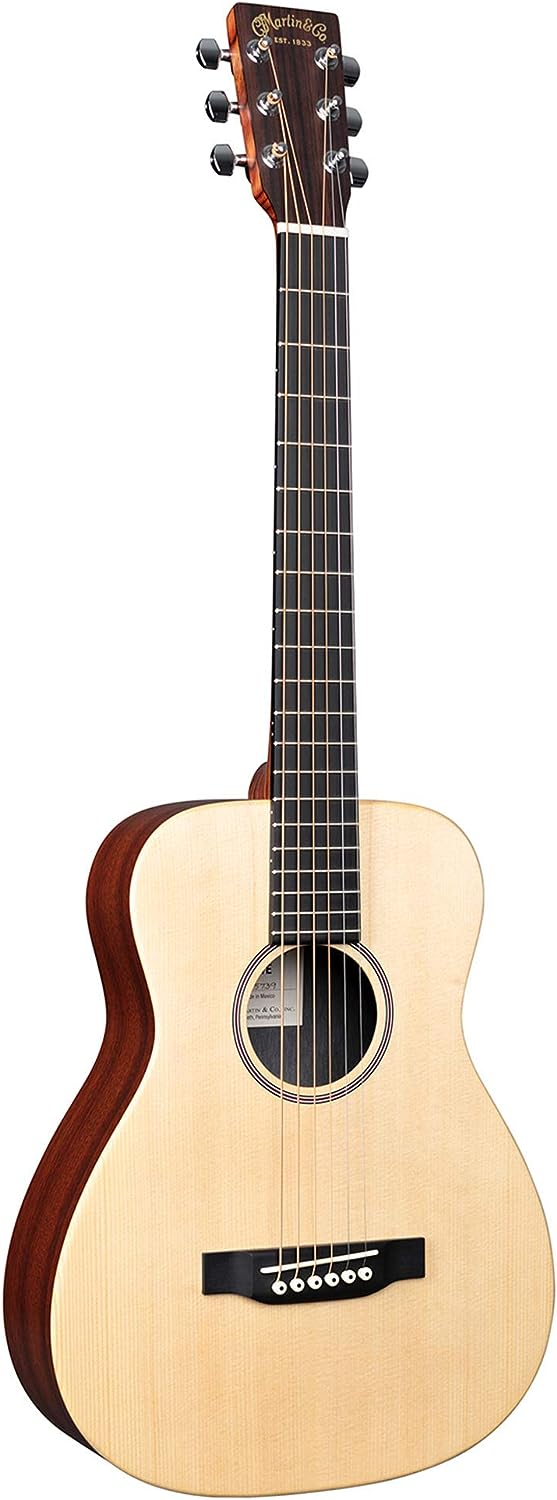
Made from high-quality materials, Martin’s Little Martin LX1E Acoustic-Electric guitar is a compact yet highly versatile instrument.
While it’s Martin’s smallest guitar, it nonetheless delivers an impressive sound quality owing to its Sitka spruce top and high-pressure laminate (HPL) design.
Whether used around a campfire or during at-home practice sessions, it guarantees a superb tone and performance.
Not just its sound, but the Little Martin LX1E boasts a striking appearance with a Sitka spruce top, mahogany HPL back, sides, and a warm satin finish, creating a visually appealing instrument.
This guitar features sustainable wood certified parts, a mortise and tenon neck joint, non-scalloped X-Brace, standard tapered neck, and chrome-enclosed gear tuners.
Enhancing its playability, these guitars are known for Martin’s iconic tone that suits genres ranging from rock and country to folk, bluegrass, and jazz, providing a playing experience that you will love.
The guitar’s materials are heavy-duty and designed to withstand long-term usage, making it an apt choice even for late-night jams or extended studio sessions.
Available in an array of wood types, you can choose the one that matches your playing style and music preference.
Particularly, designed for beginners, this model suits all ages and ability levels, its compact body making it an excellent travel companion. Each model has unique characteristics that further enhance its personality, performance, and playability.
Martin has been trusted by musical artists worldwide for its high-quality, handmade guitars and string products, and the Little Martin series surely keeps up with the legacy.
- My Review
When I first picked up the Martin LX1E Little Martin, I felt the allure of the handcrafted design and quality.
The small form-factor, combined with its solid Sitka spruce and mahogany hybrid laminate structure, immediately indicated its suitability for both home practice and travel.
The guitar offers a portable solution without compromising on the rich and professional sound I expected.
Its comfortable playability truly surprised me as it catered well to my style of playing, be it folk, country, rock or anything in between.
Not only does its sound impress, but the guitar’s appearance is equally captivating with its warm satin finish and chrome-enclosed gear tuners.
I found the sustainable certified wood of top-notch quality, ready to withstand my late-night jam sessions, constant picking, and even long studio rehearsals.
Since I am a music lover seeking both performance and durability, the Martin LX1E serves me well.
I find the guitar’s electronics, particularly the Fishman Isys T pickup, to be quite satisfactory, delivering a detailed tone when amplified.
Despite being battery-powered, this system provides a good range of control over tone and volume.
However, the tuning system could be improved as I noticed the tuner’s tuning to be a few cents off.
One noteworthy aspect is, despite its sturdy build, the Little Martin isn’t immune to humidity and temperature fluctuations.
This does require a bit of extra attention, especially on concert trips or if you live in a climate with extreme seasonal changes.
Furthermore, I did hear a noticeable string buzz on high strums, which warrants a repair.
To sum it up, I find the Martin LX1E Little Martin a worthy acquisition, be it for a beginner with an ear for quality, an intermediate player for its blend of playability and sound or a gig performer for its consistent output.
Even though it may have a few hitches like the tuning and slight sound buzz, its affordability, superior sound, and pleasing aesthetics make it stand out among similar market offerings.
- Pros:
- Compact in size, ideal for travel.
- Rich tone, good acoustic-electric sound.
- Great playability, suitable for all levels.
- Cons:
- Issues with built-in tuner’s precision.
- Possible nut and string buzz problems.
- Critiques on tone quality.
My final verdict is that the Martin LX1E Little Martin Solid Sitka Spruce/Mahogany HPL Acoustic/Electric w/Gig Bag presents an impeccable blend of quality, tone, and versatility.
The robust construction and the sustainable wood-certified parts attest to its durability, making it ideal for both beginners and seasoned players.
The added electronics enrich the acoustic experience and the smaller body size makes it an excellent travel companion.
Martin’s reputation for unrivalled craftsmanship and tone is clearly visible in this model, hence, it’s worth every penny.
This guitar is not just an instrument, but a representation of Martin’s heritage and commitment to musicians world over.
Epiphone J-45 Studio Solid Top Acoustic Guitar
Excellent sound, superior craftsmanship, affordable price.
The guitar features a 6-string acoustic design with a sturdy mahogany back, neck, and sides, along with a solid Sitka spruce top. It boasts sealed die-cast tuners, rosewood bridge, and fretboard for lasting sustain and clarity. Aesthetically pleasing, the guitar’s vintage sunburst finish, nickel hardware, and expert craftsmanship ensure excellent performance for a long time.
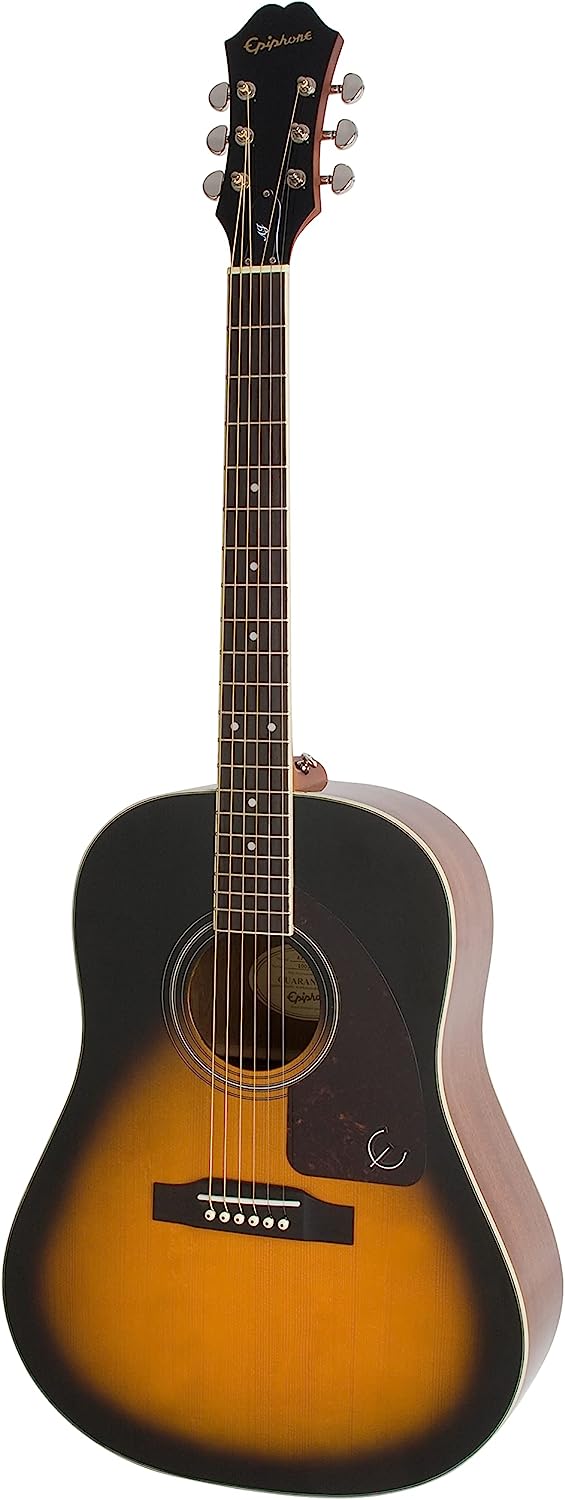
The Epiphone J-45 Studio Solid Top Acoustic Guitar is a six-stringed instrument featuring an advanced jumbo body style.
Its design includes back, neck, and sides made from mahogany, along with a top built from solid Sitka spruce, plus a rosewood bridge and fretboard.
It is a sizeable instrument with a 25-1/2″ scale sealed with die-cast tuners at a 14:1 ratio.
This guitar originates from the reputable brand, Epiphone, and has an eye-catching vintage sunburst color.
To enhance its aesthetics, and feel, the top material is crafted from Spruce wood, while the body material is a combination of Sitka spruce and mahogany.
The guitar can be played comfortably using your right-hand orientation, and features a scale length of 25.5 inches.
Made with materials such as mahogany, sitka spruce, and nickel strings, it is designed to produce rich and lasting harmonics, as well as clear tones.
This acoustic guitar looks as good as it sounds due to its beautiful finish and superior appointments.
The Epiphone AJ-220S is an elegant instrument that delivers superior sound quality, made possible by its large sound chamber, durable mahogany neck and rosewood fretboard.
Additionally, the instrument features sealed die-cast tuners and nickel hardware which not only adds to its beautiful look but also its exquisite sound.
It is important to note that the guitar was crafted under the skillful hands of Epiphone’s master craftsmen, hence it’s expected to provide excellent sound for a long period of time.
- My Review
After spending some quality time with the Epiphone J-45 Studio Solid Top Acoustic Guitar, I’ve found the instrument to be a satisfactory balance between price and performance quality.
Playing the guitar myself, I found the acoustics to be quite impressive as it provide a full and rich sound.
One aspect that won my heart is the advanced jumbo body style, it really adds a unique aesthetic and character to the instrument.
On the topic of construction, it boasts a combination of mahogany back, neck and sides, along with a solid Stitka spruce top that entails remarkable visuals.
It’s evident that the intent was to create an instrument with emphasis on durability and performance.
A noteworthy feature of the guitar includes its 25-1/2″ scale length, providing it with a slightly brighter tonal quality compared to standard Gibson models.
For performers who prefer a smooth strumming experience, the Rosewood bridge and fretboard delivers in that aspect.
I acknowledge that tuning might be needed out of the box, but this seems to be an industry standard and you would find that sealed die-cast tuners with 14:1 ratio assist greatly in this aspect.
However, in the process, I also encountered some limitations with the guitar.
One must understand that although it is high on aesthetics and sound, some fret buzz occurred, particularly around the 12th fret, which might interfere with high pitched chords or solos.
I also noticed a slight warping in the neck, which leads to the strings laying flat, causing rubbing on the frets.
Despite these niggles, it’s a reasonably priced instrument, designed for both beginners looking for their first guitar, and seasoned performers wanting a spare instrument for practice.
I’d even suggest it as a good quality backup to take on the road provided you manage the aspects that need attention.
To surmise, the Epiphone J-45 Studio Solid Top Acoustic Guitar strikes as a trustworthy blend of affordability and quality, making it a worthy investment provided that the minor issues are taken into consideration.
- Pros:
- Quality sound and tone.
- Excellent craftsmanship.
- Good value for price.
- Cons:
- Potential neck warping.
- Sharp frets on the neck.
- Reports of fret buzz.
My final verdict is that the Epiphone J-45 Studio Solid Top Acoustic Guitar (Vintage Sunburst) is an exceptionally priced guitar with quality beyond its cost.
From its advanced jumbo body design, the guitar produces deep, loud, and rich harmonics.
The durable mahogany neck and the combination of Sitka spruce top and mahogany back and sides guarantee long-lasting sound excellence.
The elegant appointments such as die-cast tuners and nickel hardware make it even more appealing aesthetically.
Therefore, both in terms of sound and aesthetics, this guitar is highly recommended for guitar enthusiasts on a budget.
Taylor 324ce Acoustic-Electric Guitar
Taylor 114ce combines natural materials for premium sound.
The item is a beautiful 6-string acoustic-electric guitar, made with a spruce top and ebony fretboard, walnut back sides, and a maple neck. Its natural color showcases the top-grade Ebony and Sapele wood materials used in its construction. Suitable for left-handed players, it features a Tune-O-Matic bridge system and nylon strings for a perfect sound experience.
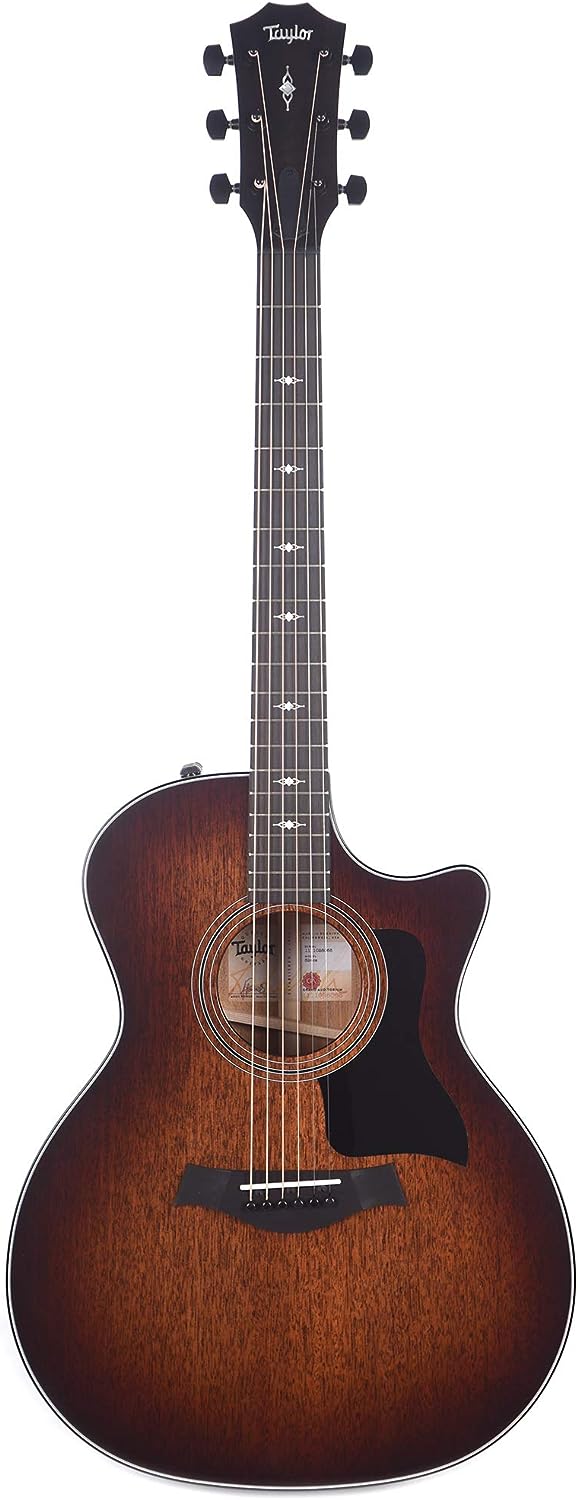
Distinguished by its characteristic Grand Auditorium design, the Taylor 114ce is an acoustic-electric guitar of remarkable craftsmanship.
A 6-string model, it boasts a spruce top that offers a pleasing combination of crispness and warmth in tone.
Topped off with an ebony fretboard, it allows for smooth playing, with the natural color finish enhancing its overall aesthetic appeal.
The walnut back and sides lend not only robustness to the guitar, but also contribute to its balanced sonic output.
Its maple neck is key to offering durability, while also ensuring a comfortable grip for the guitarist.
Belonging to the prestigious Taylor brand, this stunning guitar is made with choice materials, featuring a body and back fashioned out of sturdy walnut laminate.
With a neck made of walnut wood and a fretboard of ebony wood, this is a guitar built to execute notes with clarity and precision.
Adapted for a left-hand orientation, it uses nylon strings that are revered for their rich tone, and also includes the trusted Tune-O-Matic bridge system for accurate intonation and string action adjustment.
All these elements come together beautifully, resulting in a guitar that truly embodies the high quality associated with the Taylor name.
- My Review
Let’s talk about the Taylor 114ce Acoustic-electric Guitar.
Upon first glance, you might notice the beautiful, natural tone of this instrument, undoubtedly derived from the quality ebony and sapele woods utilized for its crafting.
Something that particularly invigorates me is the guitar’s distinctive grand auditorium design.
It not only adds an unmistakable charm to the appearance but also impacts the acoustic resonance, delivering clear and resonant tones that are treasured by seasoned musicians.
The spruce top, coupled with walnut laminate sides and a defined walnut back, help create a robust sound quality that is simply unmatched.
Currently, my hands are gravitating towards the ebony fretboard, which is not only visually appealing but also offers excellent playability.
I often lose myself in the melodious symphony that these beautifully crafted frets produce when struck with precision.
I must say, the guitar’s Tune-O-Matic bridge system, alongside the nylon strings, produces a pure and clear sound – a testament to Taylor’s unwavering commitment to quality and aesthetics.
After spending considerable time with this guitar, I’ve observed that its volume jumps off the strings, providing a vibrant and full-bodied auditory experience.
On the electric side of things, I cannot help but appreciate the state-of-the-art pickups that deliver crisp and amplified sound.
I have noticed, though, that the walnut laminate body tends to give the sound a mid-frequency focus.
While this brings uniqueness to the sound quality, it may not cater to everyone’s preferences, especially if you have a liking for low frequency or high frequency clarity.
I’d like to spend a moment admiring the durability of this guitar.
Despite being rigorous in experimenting with sound variations, I have yet to see more than a scratch on the body of this well-made instrument.
Lastly, the electronic components are decent enough for stage use – yet, for a more intimate and accurate sound, mic it up during your jamming sessions.
- Pros:
- Distinctive, mid-range sound.
- High durability and resistance.
- Great for both stage and recording.
- Cons:
- Possible issues with neck cracking.
- Electronics could be improved.
- Doesn’t develop “worn” aesthetics easily.
My final verdict is that the Taylor 114ce Acoustic-electric Guitar – Natural is an excellent choice for both beginners and experienced players.
The Ebony and Sapele Wood top, Walnut Laminate body and back, and the Walnut Wood neck make it a powerhouse of sound and durability.
Its distinctive Grand Auditorium design is visually appealing and adds to the overall quality of the performance.
The Tune-O-Matic bridge system and nylon strings offer superb resonance and ease of play.
This guitar offers incredible value for its price, making it a worthwhile investment for any passionate guitarist.
Martin D-15M Acoustic Guitar
Handmade Martin Guitar delivers professional sound and playability.
Crafted from top-quality mahogany, this acoustic guitar offers professional sound with rich tonal complexity and a stunning satin finish. Designed with the working musician in mind, it comes with a gig bag, features like a simple dovetail neck joint and non-scalloped X-brace for enhanced playability. It’s from Martin’s 15 Series, known for its superior quality and handcrafted guitars loved by musicians globally.
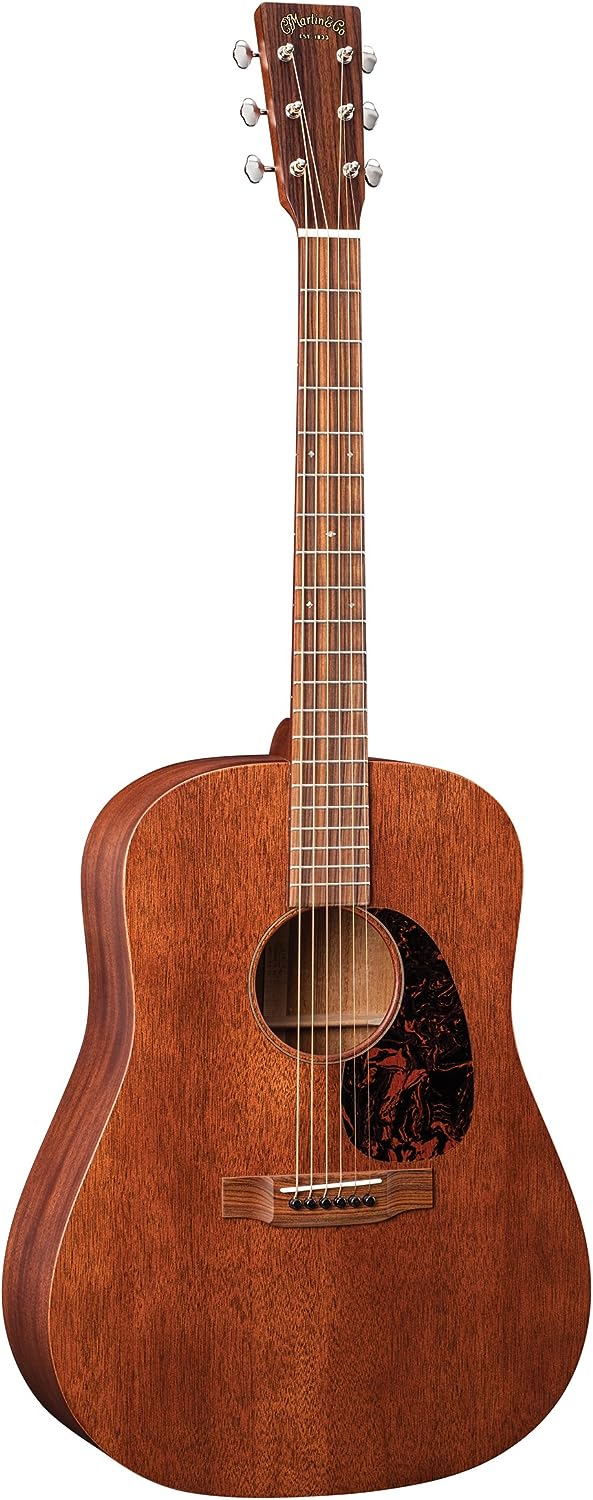
Martin Guitar’s D-15M offers an impressive mahogany construction that ensures a lively and intricate tonal sound complemented by a dreadnought body, providing a rich bass response.
This particular design is extremely adaptable, making it a wonderful choice for guitarists.
Its eye-catching open nickel tuners and satin finish give it a professional look. Perfectly suited for on-stage performances, the guitar is designed specifically for the working musician.
Its simple dovetail neck joint, non-scalloped X-brace, and standard taper neck make it a standout, and the guitar also comes equipped with a hard-shell matte case for safe transportation.
As with all Martin’s 15 Series guitars, this one is handcrafted from the finest mahogany.
Built to withstand extensive use, it’s perfect for late-night jam sessions, long studio records, or just casual strumming at home.
The enhanced playability on Martin’s guitars makes them a joy to play regardless of your skill or experience. Whether you’re into rock, country, folk, bluegrass, or jazz, you’ll find that they offer a natural playing experience that is truly enjoyable.
Finally, their superior guitars and other string instruments continue to be the go-to for musicians worldwide, thanks to the unmatched quality, craftsmanship, and tone. Each Martin guitar is still handcrafted, setting the standard in music instruments.
- My Review
Having had the opportunity to experience the Martin Guitar D-15M, I discovered that it is more than just a simple acoustic guitar.
Firstly, its construction is pure quality – crafted entirely from mahogany, it exudes a comforting and unmistakable sturdiness.
The sound that this instrument produces will effortlessly resonate with any music lover.
Breathing life into each strum, the mahogany body infuses melodies with a rich tonal complexity, boasting an impressively resonant bass response courtesy of the guitar’s dreadnought body style.
There’s a notable enhancement in my playability, thanks to the low oval neck shape and D-14 fret, which caters to every command with ease and precision.
Open nickel tuners add another level of convenience to the performance, while the satin finish carries an appealing charm.
Specially designed for the working musician, I found the Martin Guitar D-15M adaptable and versatile for any genre, be it rock, country, folk, bluegrass, or jazz.
The fine orchestration of the mahogany construction, inclusive of the back, neck, and body, combined with a spruce wood top material, serves to enhance the guitar’s tonality greatly.
While playing the instrument, I found myself intrigued by the unique nickel string material type, providing a unique sound quality.
The D-15M comes along with a hard-shell matte case, which ably ensures the guitar’s protection and easy mobility, a feature that every performing musician like myself will value.
However, it is important to note that I came across certain wood imperfections and a dent on my Martin D-15M, which, although they didn’t affect the excellent sound quality, were cosmetic blemishes on this otherwise beautifully made guitar.
Another aspect of the guitar I’d like to mention is its action, which, though great for a deep and rich sound, I found to be slightly high and might need some adjustment based on personal preference.
Nevertheless, the quality sound, impeccable craftsmanship, and durability make the Martin Guitar D-15M a fantastic choice any day.
Irrespective of these minor imperfections, the Martin Guitar D-15M remains a pride to own, offering an unrivaled, professional musical experience.
- Pros:
- Professional sound and appearance.
- Geared towards gigging musicians.
- Receives strong positive reviews.
- Cons:
- Possible delivery in extreme temperatures.
- Potential wood blemishes.
- Action might require adjustments.
My final verdict is that the Martin Guitar D-15M is a fantastic choice, especially for professional musicians.
The mahogany construction gives this guitar great sound and durability, suiting a wide variety of music styles.
Its ease of play and adaptability make it a pleasure to pick up and a workhorse for gigs or studio sessions.
The fact that it’s entirely handmade attests to its high level of craftsmanship.
It’s a worthy investment for anyone serious about their music.
What Features to Look for in a Studio Recording Acoustic Guitar?
When considering acoustic guitars for studio recording, several crucial features come into play.
Firstly, we must pay attention to the type of wood used in the instrument.
Different woods promote different tonal qualities, from bright, articulate sounds to darker, warmer tones.
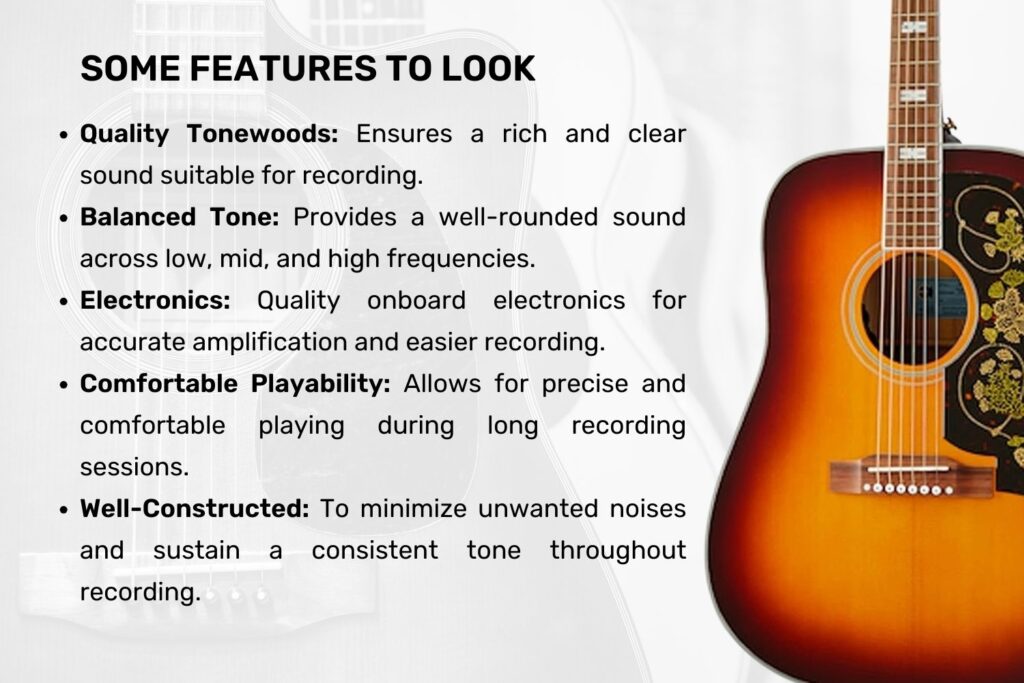
This impacts the way the recorded sound will fit into a musical arrangement, making a mahogany-bodied guitar a good fit for a dense mix, for example.
Besides the main body, consider the wood type of the guitar’s neck, as denser woods like mahogany or maple tend to sustain notes more than lighter woods.
The top wood, often made of spruce or cedar, also factors in sound quality, with spruce producing a broad dynamic range, while cedar results in a quicker note decay.
Then comes the acoustic guitar’s body style, which can greatly affect the music’s sound as larger body types tend to produce fuller, more resonant sounds than smaller body styles.
Another vital feature is the string type, where nylon strings typically yield a softer, mellower sound, and steel strings produce brighter, louder tones.
Different string tensions, from light to medium and heavy, can also influence the tonal output of the guitar, with heavier tension usually leading to higher volume and tonal fullness but requiring more finger pressure.
A lesser-known but critical factor is the guitar’s neck joint, which can impact the sustain and vibrational transfer of the acoustic guitar.
Set necks, where the neck is glued to the body, often offer more sustain and tonal warmth, while bolt-on necks are typically brighter and snappier.
The bridge system is another indispensable feature, it is where the strings are anchored to the guitar’s body and it plays a crucial role in sustain and transferring the vibrations from the strings to the guitar’s top.
Various bridge materials, such as rosewood, ebony, and synthetic materials, can subtly affect the guitar’s tone color.
The question of whether the guitar is solid or laminated is also important, as solid wood guitars tend to resonate more freely and produce a richer, more nuanced sound than laminated ones, which are more affordable and resistant to humidity and temperature variations but often yield a less vibrant, nuanced sound.
Each company uses its unique blend of materials, craftsmanships, and design concepts, leading to a distinct sonic identity, influencing the final choice, making the distinction between different guitar brands.
The appearance and aesthetics of the guitar are also valuable, as a visually appealing instrument can inspire the musician and enhance the creative process.
As a final note, remember that keeping the guitar well maintained, from changing strings regularly to proper cleaning and humidity control, can have a significant influence on its playability and sound, thus affecting the recording quality.
Ultimately, the best acoustic guitar for studio recording depends on your specific needs, musical style, and personal preference.
Your ears are your best tool in discerning the right instrument for you, so take the time to play and listen carefully to a variety of guitars before making your decision.
How Does Wood Type Affect the Sound of Acoustic Guitars?
The unique nature of the wood type used in making an acoustic guitar greatly contributes to the sound it produces when played.
A significant role in the creation of an acoustic guitar’s tone is played by the type, density, and quality of wood used.
Due to their distinct characteristics, different woods are selected for the various components in an acoustic guitar.

One major factor in the making of a guitar is the top or soundboard.
Spruce is typically the preferred choice for the top due to its remarkable strength-to-weight ratio, leading to clear and loud sounds.
Another commonly used wood type is Cedar, preferred for its warmer tonal characteristics suitable for finger-style guitars.
The back and sides of a guitar significantly influence its sound projection and tonal flavor.
Woods such as Mahogany and Rosewood are frequently used in these areas.
Between these two, mahogany projects a midrange-focused sound making it a popular choice for blues artists while rosewood is known for its rich overtones, making it a prime choice for many genres.
The construction of the neck and fretboard also affects the overall guitar sound and playability.
Typically, necks are made from mahogany for its balanced tone and strength, while fretboards often feature rosewood or ebony for their hardness and durability.
It’s essential to note the difference in sound between a guitar made from solid wood and one constructed from laminate.
Generally, solid wood guitars have a more resonant and rounded tone, while laminated counterparts may deliver a sound that’s less complex.
As a result, solid wood guitars are often preferred in a studio recording environment for their tonal superiority.
However, advancements in laminate construction have led to improvements in sound, but solid wood guitars still hold the edge.
The wood grain pattern, age, and treatment also play a role in shaping the guitar’s sound.
A well-made guitar, regardless of the wood used, will likely sound good, but the choice of wood can subtly alter the tonal characteristics.
In a recording studio, these small differences can have a profound impact on the final product and can ultimately contribute to the personal signature sound of a recording artist.
Finally, the selection of the right sonic properties of a guitar’s wood will depend on the specific style and genre of music to be played.
What String Types Are Recommended for Studio Recording?
The choice of string types plays a crucial part when it comes to recording acoustic guitar music in the studio.
There are several varieties of guitar strings available in the market, each catering to specific genres, tones, and playing techniques.
The two most commonly used string types in studio recordings are steel and nylon.
Steel strings are typically used on acoustic guitars and tend to provide a bright, loud, and full-bodied sound ideal for rock, country, and pop music.
On the other hand, nylon strings, typically found on classical guitars, produce a softer, mellower tone, and are favored for classical or flamenco genres.
Furthermore, the gauge or thickness of the strings also materially affects the guitar’s sound and playability.
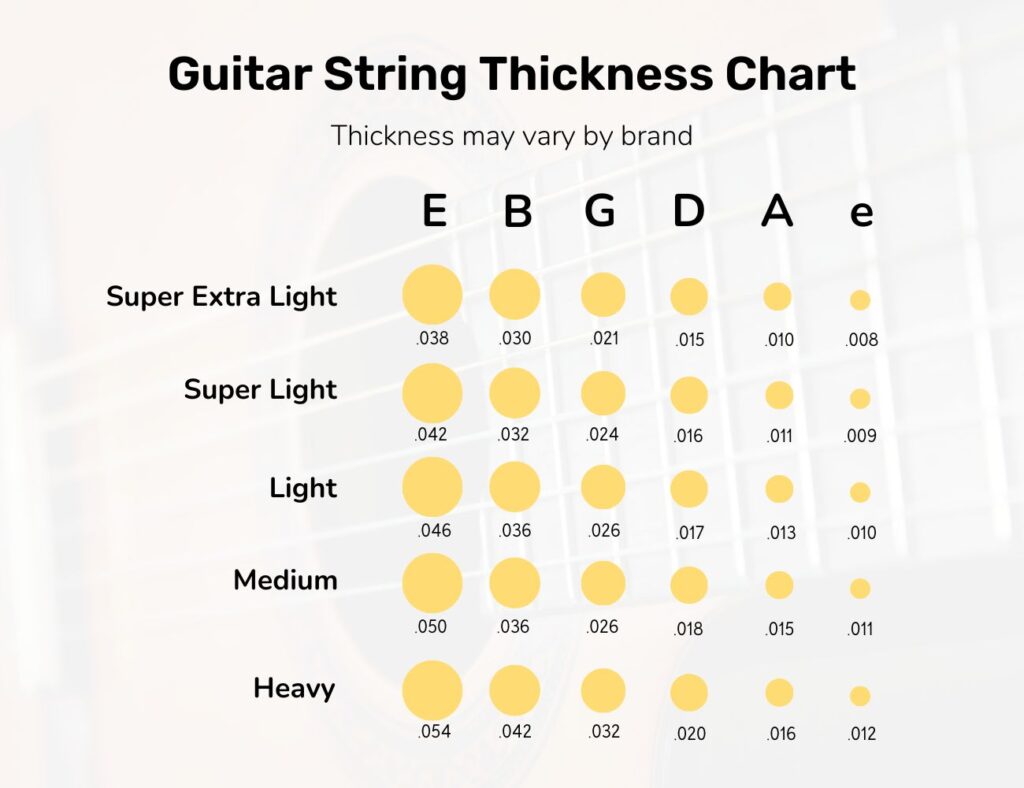
Lighter gauge strings are easy to play and produce a bright and crisp tone, yet they’re prone to breakage and may not carry the same volume and sustain as their heavier counterparts.
In contrast, heavier gauge strings produce a rich and full tone with the added benefit of increased sustain and volume but require more finger strength and pressure.
Studio professionals often select string gauges based on the desired tone and genre of music being recorded.
Another point to consider when choosing strings for studio recording is the material composition of the string.
Phosphor bronze strings, made from copper and tin alloy with phosphor, known for their warm, mellow, and balanced tone, are a popular choice for studio recording.
80/20 Bronze strings, made from 80% copper and 20% zinc alloy, offer a crisp, bright, and punchy tone that pairs well with a variety of music genres.
Coated strings, whether phosphor or 80/20 bronze, extend the string’s longevity by protecting against dirt, sweat, and other elements that can quickly degrade the string’s tone and lifespan.
The choice of string type may also be governed by the specific recording technique used in the studio.
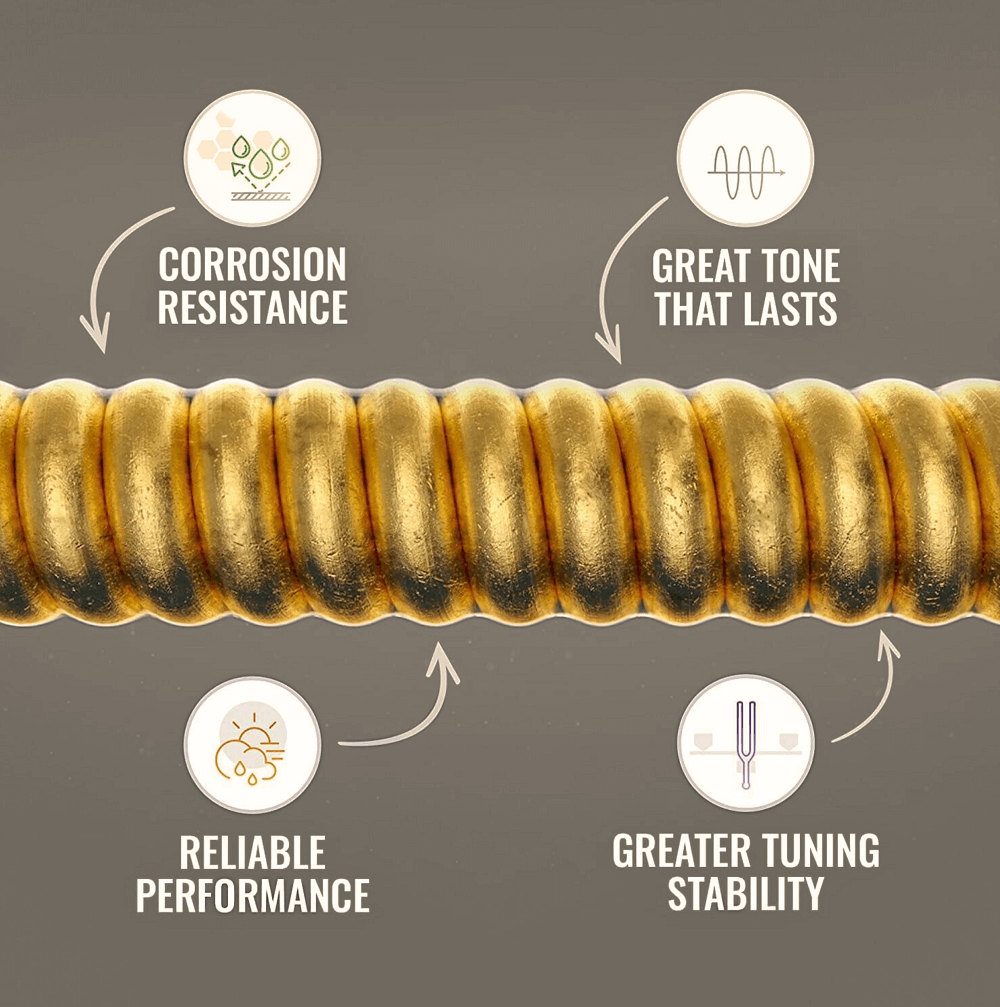
For example, finger-style players may opt for light to medium gauge strings, while those using a pick may prefer medium to heavy gauge strings for increased volume and body.
Finally, one shouldn’t underestimate the importance of string freshness on the sound quality of acoustic guitars in studio recordings.
Fresh strings present a bright, crisp, and dynamic tone, which is often desired in a recording.
Therefore, it is recommended to replace the strings before a recording session to ensure optimum sound quality.
Does the Shape and Size of an Acoustic Guitar Impact Sound Quality in Recordings?
When it comes to studio recording, the shape and size of your acoustic guitar can significantly influence the end-result.
The physics of sounds and resonance are at play when it comes to the shape and size of a guitar, which undoubtedly affect the quality of sound produced.
A fuller and bigger-sized acoustic guitar tends to produce a stronger, bassier tone since larger bodies have more room to amplify and enhance lower frequencies.
Meanwhile, smaller-bodied guitars, famous for their clear and more focused tone, are often preferred for detailed finger-style playing, because they emphasize higher frequencies.
This distinction is essential in a recording studio setting where capturing every tonal nuance is a requirement.
For instance, a dreadnought – large and most recognized shape in acoustic guitars – can be an excellent choice for a recording that requires a powerful, driving rhythm.
While a Parlor guitar – small and compact – can strike a perfect balance in a recording that requires a more delicate and distinct tone.
However, the shape of an acoustic guitar also comes into play when considering the comfort and playability, especially during long recording sessions.
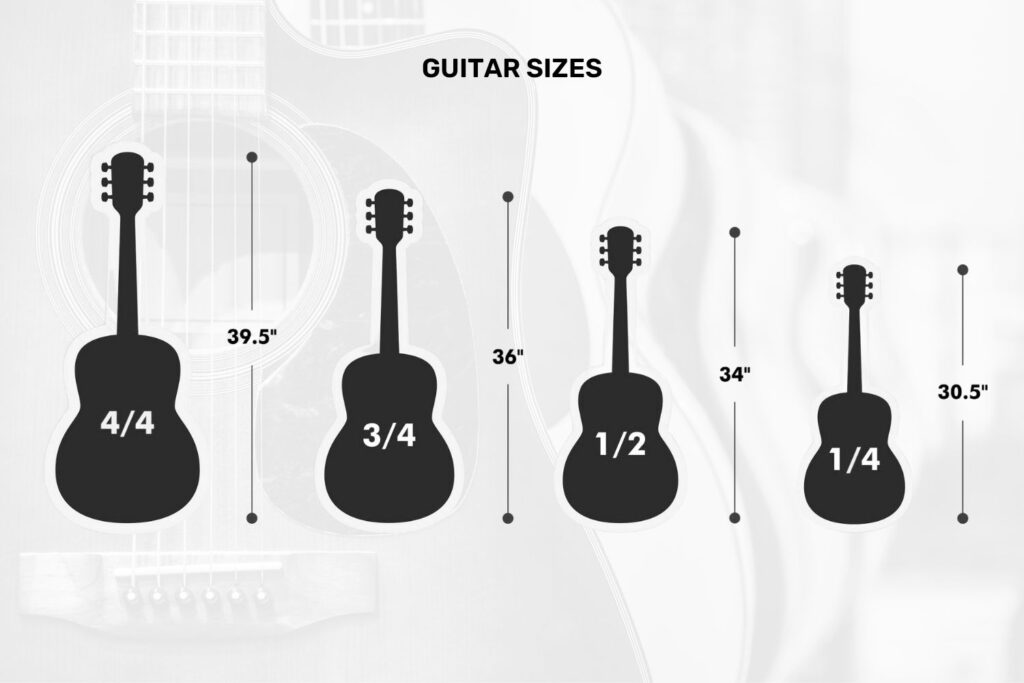
A large guitar might be difficult for a smaller person to manage whereas a smaller guitar might not feel as comfortable for someone used to a larger instrument.
The upper bout width, or the size of the guitar at its upper body, can affect how closely the guitar sits to your body, as well as how you strum or pick the strings.
On the other hand, the lower bout width, largest width of a guitar at its bottom half, significantly affects the guitar’s tonal properties and resonance.
Lastly, but not least, the depth of the guitar. A deeper bodied guitar tends to exhibit more amounts of bass, but can also sound boomy or muddy if not properly controlled.
Understanding the relationship between a guitar’s shape and size and the quality of sound it produces can significantly enhance a musician’s ability to create a desired sound in a recording setting.
This understanding can also allow them to create a more personalized and unique tone that sets them apart from others.
Remember when choosing your next guitar for studio recording, don’t simply rely on the overall aesthetics of the guitar; take into consideration the shape, size, comfort and tonal impact it brings to your music.
A well-chosen acoustic guitar, suitable for your music style and personal comfort, can be your most trusted ally in delivering a fantastic recording performance.
What is the Significance of the Neck Joint in Acoustic Guitars for Studio Recording?
The neck joint is a critical component in acoustic guitars.
It is responsible for connecting the guitar’s body to the neck, a connection that profoundly impacts the guitar’s tonal quality and resonance.
Let’s delve deeper into how the neck joint contributes to studio recording.
Resonance and sustain are two major aspects that a neck joint directly influences.
When the neck and the body of the guitar are firmly joined, the vibrations from the strings can freely move across the entire instrument, allowing for greater resonance and sustain – features incredibly important when recording in a studio setting.
Not only this, the construction and type of the neck joint also plays a significant role.
Generally, there are three types of neck joints in acoustic guitars: dovetail joints, bolt-on necks, and mortise and tenon joints.
Many believe dovetail joints, a traditional construction method, provide the richest and most vibrant sound. This is due to their ability to facilitate maximum energy transfer between the neck and body.
Bolt-on necks, on the other hand, are relatively easier to adjust and repair. While they may not provide the same level of warm resonance as dovetail joints, they are favored for their precise sound, high frequency clarity and convenience.
Mortise and Tenon joints are somewhat of a compromise between the two previously mentioned types. They preserve more tonal quality compared to bolt-on necks but fall slightly short of the rich resonance provided by dovetail joints.
It is important to note that a guitar with the perfectly crafted neck joint will ensure smooth playability and brilliant sound during your studio recording sessions.
However, the significance of the neck joint does not stop at resonance and sustain.
The type and construction of the neck joint also greatly contribute to the playing comfort of the instrument.
A neck joint that is not properly set can lead to action issues – the distance between the strings and the fretboard – making the guitar more difficult to play.
In contrast, a well-crafted neck joint will provide the player with ease and comfort, making those long recording sessions much less strenuous.
In terms of guitar repair and maintenance, the neck joint also bears significance.
For instance, bolt-on necks are easier to replace or repair than dovetail joints, which require experienced craftsmen and could take time.
This aspect of convenience and maintenance could make a notable difference especially in a studio context, where time is often of the essence.
Thus, the significance of the neck joint in acoustic guitars for studio recording should not be underestimated as it greatly aids in achieving optimal resonance, projection, playability and ease of maintenance.
So, when choosing an acoustic guitar for studio recording, remember to pay special attention to the neck joint, as this often overlooked feature can profoundly impact your recording experience and the overall sound quality of your music.
How Important is the Bridge System in Studio Recording Acoustic Guitars?
The bridge system on an acoustic guitar serves a crucial role.
This namely, conveying the vibrations from the strings to the guitar’s body.
The bridge directly contributes to the tonal qualities and sustain of an acoustic guitar.
A guitar’s ability to sustain notes and its overall tone quality is highly influenced by the bridge system’s effective transmission of string vibrations.
Therefore, the importance of a good bridge system for studio recording cannot be overstated.
In studio recording, capturing the best possible sound quality is critical.
The type of bridge system on a guitar can significantly contribute to the overall sound quality that gets captured during recording.
Many factors constitute a good bridge system, and different manufacturers implement these factors in unique ways.
A good example of this is the material used to make the bridge system.
Commonly used materials include rosewood and ebony, each imparting distinct tonal characteristics on the guitar sound.
The type of glue used to attach the bridge to the guitar body also matters a lot.
A strong bond between the bridge and guitar body allows for efficient transmission of string vibrations, and thus improved sound quality.
The placement of the bridge on the guitar body is another critical aspect.
Incorrect positioning can lead to intonation problems, negatively impacting the recorded sound.
The bridge’s saddle and support structure also come into play.
The saddle material, along with its shape and height, can all impact the guitar’s sound.
If these elements are not made or installed correctly, they can cause various problems, including a reduced sustain or even string buzzing.
Furthermore, when selecting a guitar to use for studio recording, examining the construction of the bridge system is essential.
Therefore, the quality of a bridge system often gets reflected in the price of the guitar.
It is worth investing in a guitar with a well-made bridge system for better studio recording.
However, it is also essential to note that a good bridge system alone cannot guarantee a great recording.
Other factors such as the recording environment, playing technique, and the type of microphone used in recording also play significant roles.
Having a sound bridge system is a necessary, but not sufficient, condition for a good studio recording.
Despite the importance of the bridge system, a guitar’s sound will always be the result of a combination of several elements working together.
In a way, the bridge system acts as the “heart” of the guitar, pumping life into the strings and body and producing the unique sound that sets each guitar apart.
So, every detail regarding its construction and setup plays a part in creating the sound that acoustic guitars are loved for.
A well-constructed bridge system significantly improves an acoustic guitar’s sound quality, making it an essential consideration when choosing a guitar for studio recording.
Is there a Notable Difference Between Solid or Laminated Acoustic Guitars in Recordings?
The material composition of an acoustic guitar, particularly between solid and laminated woods, plays a critical role in the guitar’s sound quality and overall performance, especially in studio recordings.
Solid wood guitars are manufactured from a single piece of wood, making them highly cherished instruments for recording.
They tend to provide a rich and full tone that resonates well and has the ability to improve with time the more it is played.
This is attributed to the fine vibrations that age the wood naturally, resulting in an enhanced warm tone.
Furthermore, solid wood guitars emanate a deeper and louder sound which is highly desirable in a studio recording environment.
Conversely, laminated wood guitars consist of several layers of wood pressed together.
While they may be more durable and resistant to changes in humidity and temperature, their sound quality is often considered inferior to solid wood alternatives.
This is due to the fact that the excessive glue and heat used during the lamination process can impede the wood’s natural resonance, resulting in a sound that is less warm and rich.
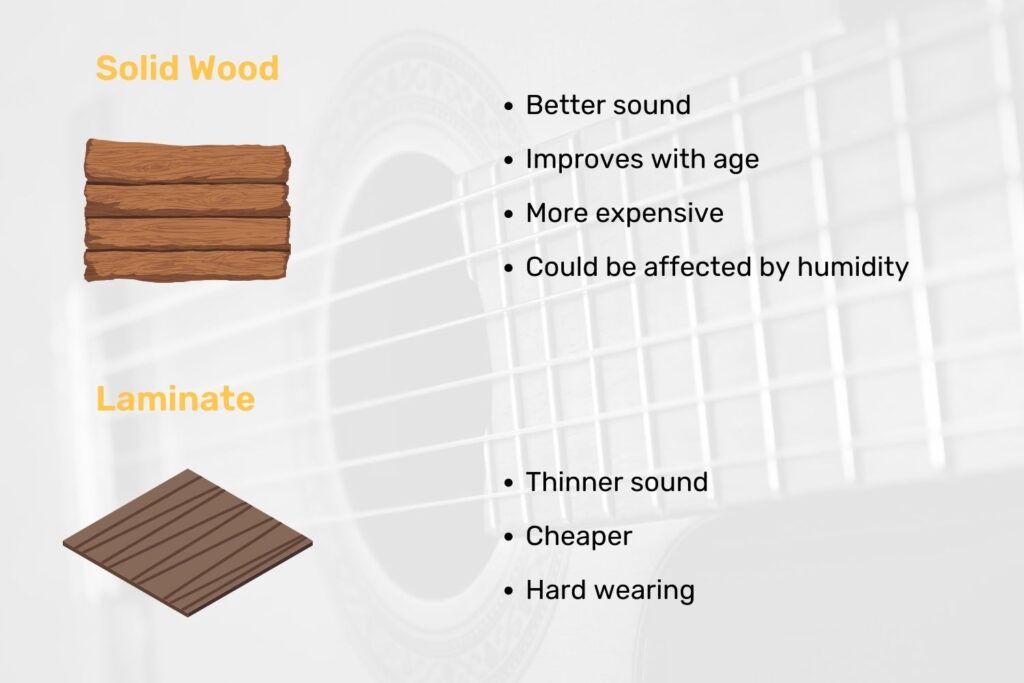
However, it’s essential to note that the execution of construction can significantly affect the sound quality of both solid and laminated guitars.
High-end laminated guitars that are expertly constructed can often outperform poorly constructed solid wood guitars, emphasizing the importance of craftsmanship.
Additionally, musicians should also consider their individual playing styles and preferred sound.
While solid wood guitars may be the gold standard for many, some musicians might prefer the unique tonal qualities of a well-crafted laminated guitar, especially for certain genres or recording settings.
Therefore, it’s crucial for musicians to play and listen to a variety of guitars made from different materials before making a decision.
In a studio recording context, the microphone placement and recording techniques can further highlight the tonal differences between solid and laminated guitars, enhancing the overall quality of the recording.
Finally, financial considerations should not be overlooked.
Solid wood acoustic guitars are generally more expensive than their laminated counterparts due to the cost of materials and the time-intensive manufacturing process.
However, their longevity and sound quality can make them a worthwhile investment for musicians looking to create professional studio recordings.
While there are notable differences in sound, longevity, and cost between solid and laminated acoustic guitars, the choice ultimately depends on the musician’s preferences and the specific recording requirements.
Which Guitar Brands are Frequently Used in Recording Studios?
When it comes to recording acoustic guitars in a studio, the brand of the guitar often plays a critical role.
Not all brands are created equal and certain brands stand out to professionals due to their consistent quality, rich sound, and durability.
Brands such as Martin, Taylor, and Gibson are frequently opted for studio recording for those very reasons.
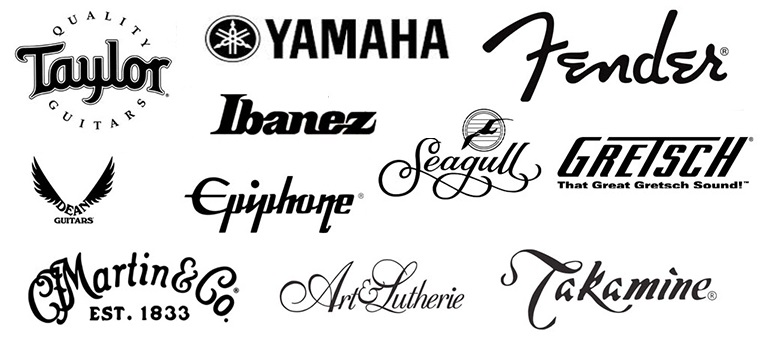
Founded in 1833, Martin is widely recognized for their premium quality.
With their distinctive tone and longevity, their guitars have become a choice for many professionals in the industry.
Eric Clapton and Ed Sheeran are among the many renowned artists who have used Martin guitars in their recordings.
Their acoustic guitars create a workable balance between the bass and treble frequencies, ensuring they are clearly audible during recording sessions.
Taylor, another popular brand, is known for their innovative guitar designs and the high quality sound they produce.
Their guitars are preferred by many because of the clarity of their notes and their wide dynamic range.
Artists including Jason Mraz and Taylor Swift have used Taylor guitars effectively in their recordings.
Gibson with their historic presence in the music industry, offers a variety of acoustic guitars that deliver a warm, full-bodied tone.
Many famous musicians such as Bob Dylan and Sheryl Crow have favored Gibson guitars in their studio recordings.
While the tonal quality, durability and design are important reasons for the selection of a particular brand, personal preference also plays a significant part in which brand is chosen for studio recording.
Some guitarists simply prefer the sound or feel of a certain brand.
However, it is important to remember that the brand of the guitar alone won’t dictate the quality of a recording.
A seasoned producer or audio engineer can make a less expensive, simple guitar sound fantastic with the right microphone placement, room acoustics, and post-production techniques.
But having a high-quality acoustic guitar certainly allows for a higher starting point in the recording process.
The guitar’s playability, or how comfortable it is to play, can also influence how the recording process goes, which is where brand reputation can come into play.
While these brands dominate the market for high-quality acoustic guitars, there are plenty of other excellent brands out there.
Guitar brands like Breedlove, Fender, and Guild also have faithful followings and are often selected for studio recording because of the unique tonal quality and playability they offer.
The best course of action when choosing a brand for a studio recording is to try out as many options as you can and select the one that is best suited for you and the sound you are trying to achieve.
Good luck in finding the perfect guitar to bring out the best in your studio recordings.
Should You Have Multiple Acoustic Guitars For Different Studio Recordings?
Choosing the right gear for a recording studio stands as a crucial decision that could potentially influence the sound you produce, and among that gear is the selection of acoustic guitars.
The question that often arises is whether having multiple acoustic guitars for varying studio recordings is necessary.
A direct answer to this is yes, there are benefits to having several acoustic guitars at your disposal for different studio recordings.
Each acoustic guitar is unique, no two guitars, even from the same manufacturer or line, will sound exactly alike.
Different guitars possess distinctive characteristics that affect the tone, volume, resonance and overall sound produced.
Having a variety of guitars allows you the flexibility to match the right guitar with the specific tone or sound you’re trying to achieve for a particular song or recording.
It’s also a matter of complementing the artist’s voice or the ambient sound of the recording.
This, of course, comes with the need of having ample knowledge of each guitar you have.
If you have more than one guitar, you can, for instance, use a small-bodied guitar for fingerstyle playing and a large-bodied one for rhythm tracks.
On the flipside, maintaining a collection of acoustic guitars could be a financial burden or logistically challenging, especially if you are running a smaller music studio or just starting out.
Further still, the importance of having multiple guitars fades if you don’t have a clear understanding of the unique sound attributes
So, while there are benefits in having a variety of acoustic guitars, it’s important to assess your individual needs, the types of music you’ll be recording, your budget, and your understanding of how different guitars influence sound.
Another advantage to having multiple acoustic guitars is the ability to tune each guitar differently.
Some songs might require a guitar to be dropped down a half or whole step, or even to be put in an open or alternate tuning.
Having multiple guitars allows you to keep one guitar tuned standard, another in an alternate tuning, and so forth, without having to retune a single guitar during a recording session.
This results in less time spent on tuning, and ensures that you stay in tune for the entirety of the recording session.
The decision of whether to have multiple acoustic guitars for different studio recordings is highly individual.
It essentially depends on your specific requirements and constraints as a music producer or studio owner.
It’s always a good idea to experience it firsthand by trying different acoustic guitars in various recording sessions, assess results, and adjust your inventory – if needed – to fit your specific recording needs.
What Guitar Maintenance Tips Can Enhance Studio Recording Performance?
Maintaining your acoustic guitar in a pristine condition becomes significantly important when considering a studio recording.
The first step is cleaning up your guitar. The sounds of a guitar can be negatively impacted by a buildup of dirt and oils.
Regular polishing of the guitar can help to keep the body and neck of the instrument clean, thus maintaining the sound quality.
Another factor to consider is the impact of humidity on acoustic guitars. These guitars, especially those made of wood, are highly sensitive to changes in moisture levels.
Therefore, ensuring your studio or storage area possesses a balanced humidity level is beneficial for the sound quality of your acoustic guitar.
Regularly changing the strings is another major aspect of acoustic guitar maintenance. Fresh strings give clearer tones and better sustain which are vital for studio recording.
Depending on how frequently the guitar is used, it may need to have its strings changed every 3 to 6 months.
Fretboard maintenance should also be a key consideration. The oils from your fingers can build up overtime and can therefore impact the quality of sound produced by the guitar.
This buildup can be combated by regular cleaning and conditioning of the fretboard.
You should also pay careful attention to the setup of the guitar. This involves adjusting the action, intonation, and truss rod.
Having a professional setup your guitar can greatly impact the playability and sound, helping it perform best in studio recording conditions.
Another key factor in maintaining the health of an acoustic guitar is ensuring it’s properly stored when not in use.
Guitars should ideally be stored in a purpose-built guitar case that provides the necessary level of protection to preserve the instrument.
Regular inspection and maintenance of the hardware of the guitar including tuning pegs, nuts, and bridges can also contribute to a higher sound quality during recordings.
Failing to maintain these elements can result in poor intonation and unstable tuning during recording sessions.
Taking care to keep the acoustic guitar properly tuned can affect its sound quality significantly in the long run.
Finally, professional servicing of the guitar at regular intervals makes a huge positive difference to the sound quality during studio recording.
Professional service will catch any minor problems before they become major ones, ensuring that your acoustic guitar remains in top condition for studio recording sessions.
The Bottom Line
After careful review, it’s clear that the best acoustic guitars for studio recording deliver an exceptional blend of tone, playability, and build quality.
While numerous factors can contribute to the perfect guitar for recording, personal preference also plays a significant role.
Hence, it’s wise to choose a high-quality guitar that resonates with your personal style and comfort.
It’s evident that investing in the right guitar enhances the quality of the studio recordings remarkably.
Remember, the guitar is the extension of your musical voice; choose wisely for it can truly elevate your recording experience.
Sources: sweetwater.com ; guitarcenter.com ; midlifeguitar.com ; guitarworld.com
In love with guitars, and gear; expert in all things music! Been writing about guitars for about 5 years and counting. Born in the ’90s. Alma Mater: University of Havana. Always curious, trying to understand the world. #TeamFender

